The latest generation of Light-eMTBs doesn’t just make trail riding more fun, but also outshine many analogue MTBs! That said, not all Light-eMTBs are equal: the differences in motor systems, performance and handling are considerable and you should know exactly what to look for. We measured up 8 of the most exciting models ranging from € 8,499 to € 15,999, giving you both our high- and low-lights of the group, as well as numerous exciting insights that we discovered during the test!
Table of content: What is in this test
- What is a Light-eMTB and who says so?
- Our Light-eMTB test field
- The motor systems of the Light-eMTBs on test, their integration options, and the software at a glance
- How and where did we test the Light-eMTBs?
- Our test crew
- Our Light-eMTB group test in numbers
- The tops and flops of our Light-eMTB group test
- An overview of the Light-eMTB test field and the winners
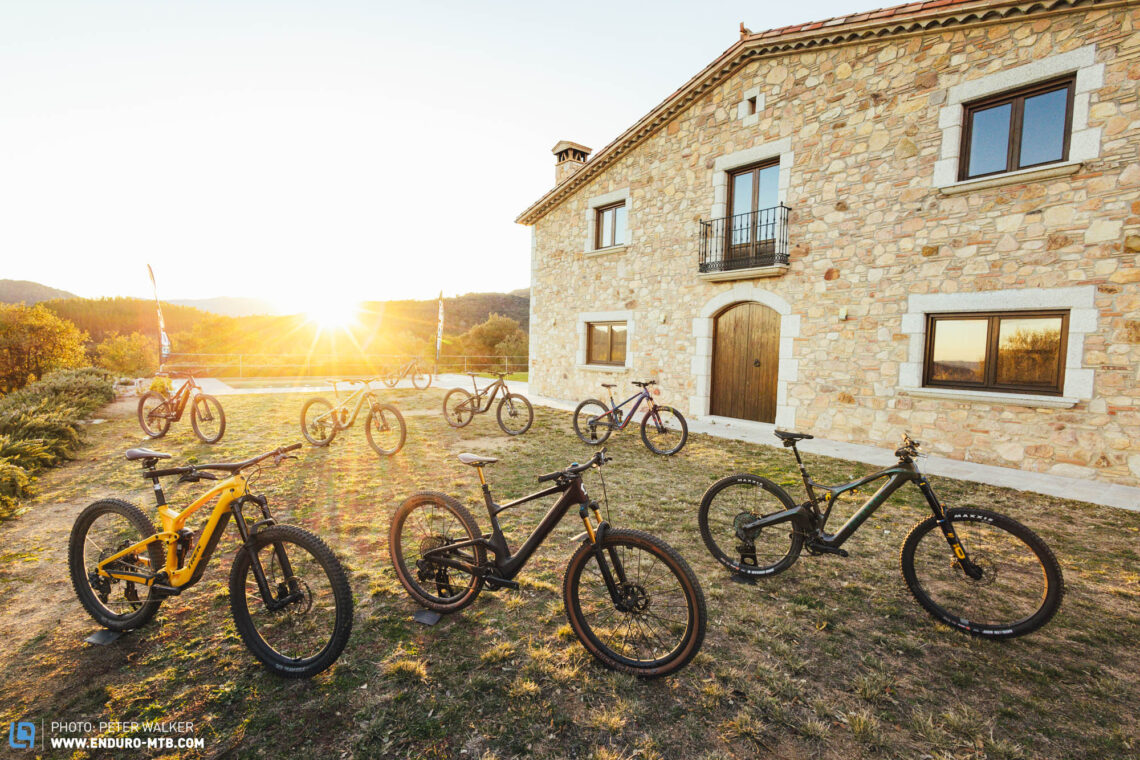
We always love hearing from our readers at ENDURO and we often get questions filling our inboxes. One of the questions we hear most frequently, and will probably keep hearing for quite a while, is whether you should buy an analogue bike or rather get an eMTB instead. Considering last year’s Light-eMTB boom and the emergence of a new Light-eMTB generation with very promising motors, we’re not surprised. As technology advances, the bikes’ performance on the trail, the possibilities, and above all, the fun you can have grows, too. More fun is what we all want, right?
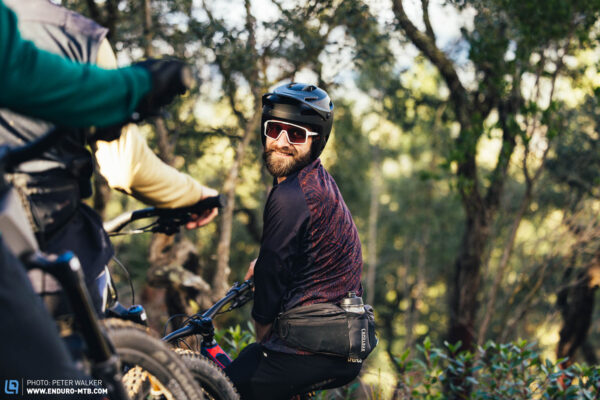
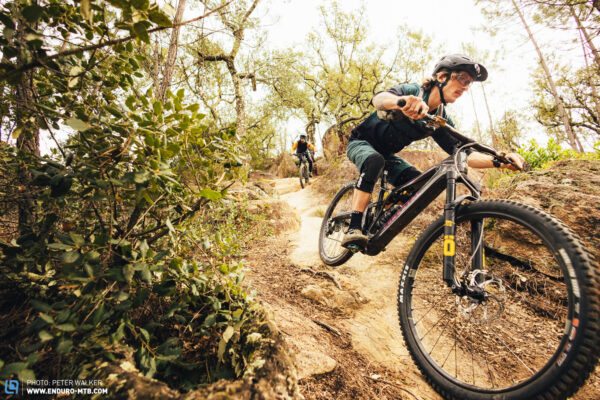
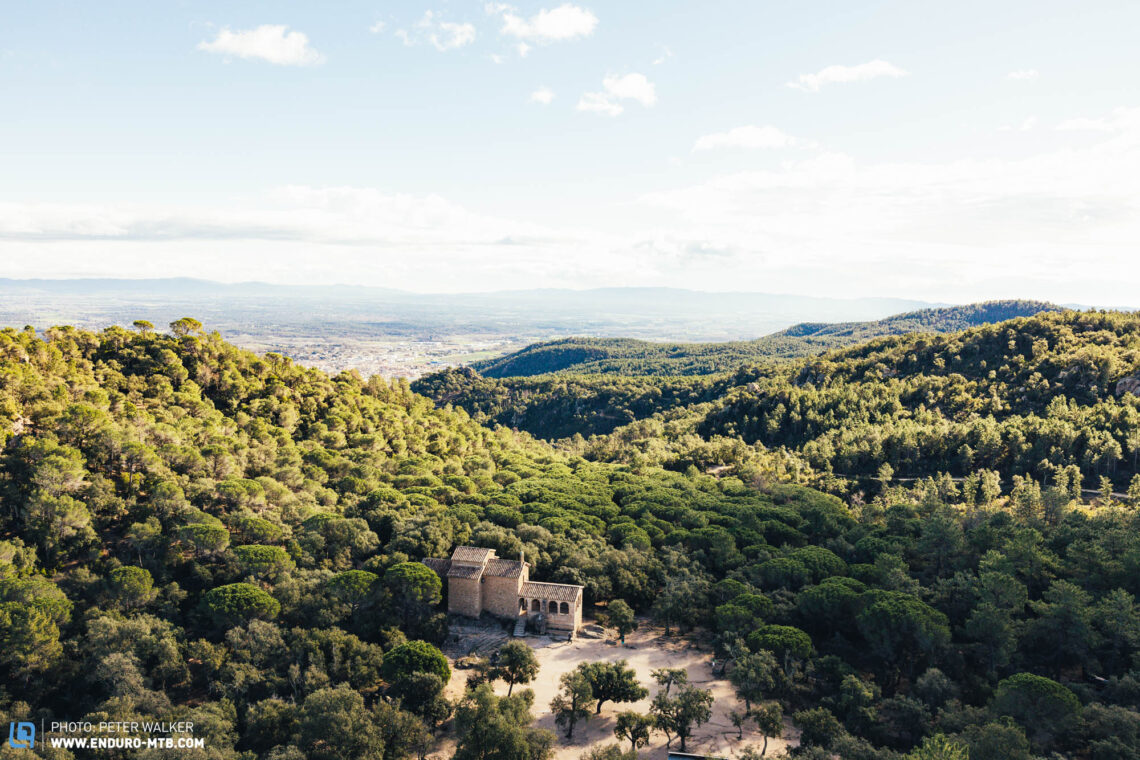
The FOCUS Raven was the first Light-eMTB to pop up on the scene in 2016, followed by the first full-suspension Light-eMTB the Lapierre eZesty a while later, and then many more like the Specialized Levo SL. However, these bikes couldn’t prevail against the bigger and more rapidly rising eMTB tidal wave, drowning in it instead of surfing it themselves. But all that’s set to change with the latest generation. Until now, the masses have been screaming for more power and bigger batteries, while the ebike haters and doubters have been growing quiet. After more than 10 years of eMTB development, we seem to have reached a peak for the first time last year as manufacturers ease off on the battery capacity arms race and realise the advantage of using smaller and more compact batteries and offering greater flexibility. It’s the perfect storm for Light-eMTBs to shake up the market!
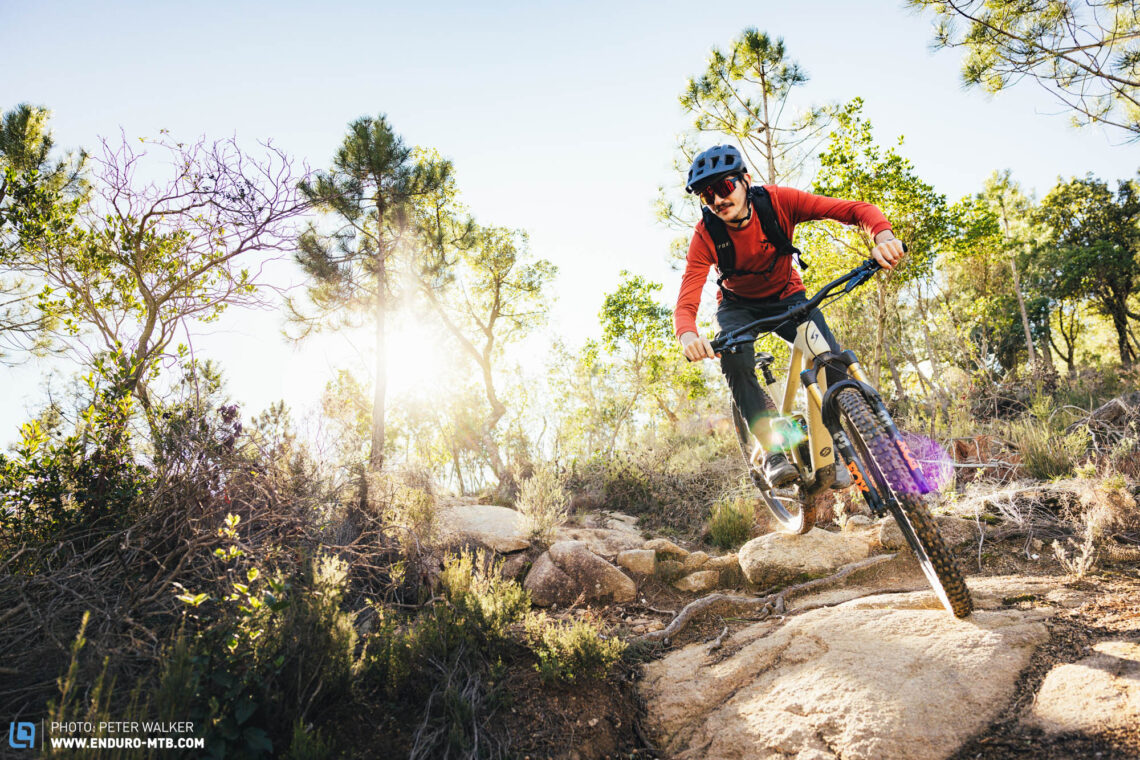
This is also due to the almost simultaneous introduction of two new light motors, the TQ HPR 50 and the FAZUA Ride 60, bringing with them a whole armada of new Light-eMTB models. The past has also shown that it usually takes large brands to get new technology to stick in the market and generate sufficient traction. So, it’s great to see manufacturers like SCOTT and Haibike jump onto the bandwagon and launch their own Light-eMTBs featuring the latest in lightweight drive unit technology. You can expect to see these bikes flooding the market over the coming months, and we predict that there will be no major bike brand without a Light-eMTB in their portfolio by the end of 2024.
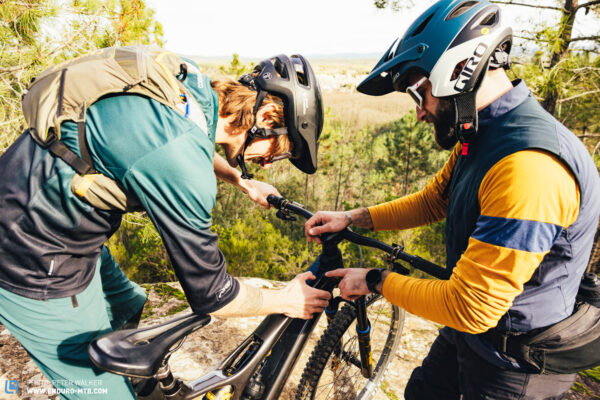
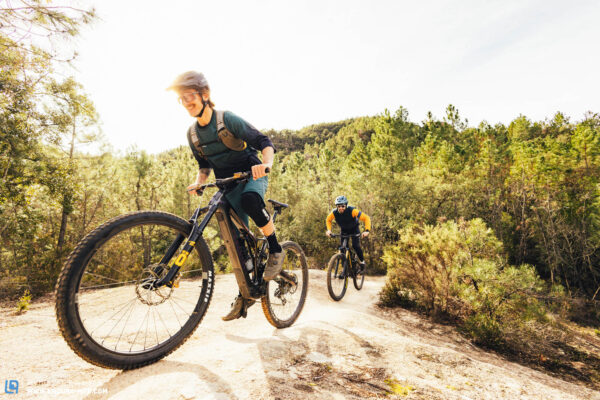
What is a Light-eMTB and who says so?
With an eMTB, the overall concept and motor system dictates the intended use. The amount of travel that the suspension offers is largely irrelevant. Long travel ebikes can be just as good for touring and everyday commuting as they are for big hits and rough trails.
The definition of a Light-eMTB isn’t as straightforward as it seems at first glance either. What does the term “light” refer to? Is a Light-eMTB necessarily a bike with a less powerful motor or a smaller battery? Or is it the complete bike weight that counts? Or are Light-eMTBs simply bikes that resemble analogue MTBs in their handling despite having large batteries, powerful motors, and a hefty weight?
True to our test philosophy, it all boils down to the overall concept – considering the individual parameters of a Light-eMTB in isolation makes as little sense as assessing the performance of an analogue mountain bike based on its geometry sheet. No, it makes even less sense! Because even the best electric motor is only as good as the bike it’s in! And a good Light-eMTB mustn’t just have the right geometry and components, but also the right combination of power, battery capacity and weight. Unfortunately, it’s often only the flagship models that take the latter into account, many of which cost well over € 10,000. If you look at the more affordable models, an 18 kg bike can quickly tip the scales at 22 kg. Nevertheless, this creates a concept that bridges the gap between analogue bikes and full-power eMTBs on the trail and in terms of handling.
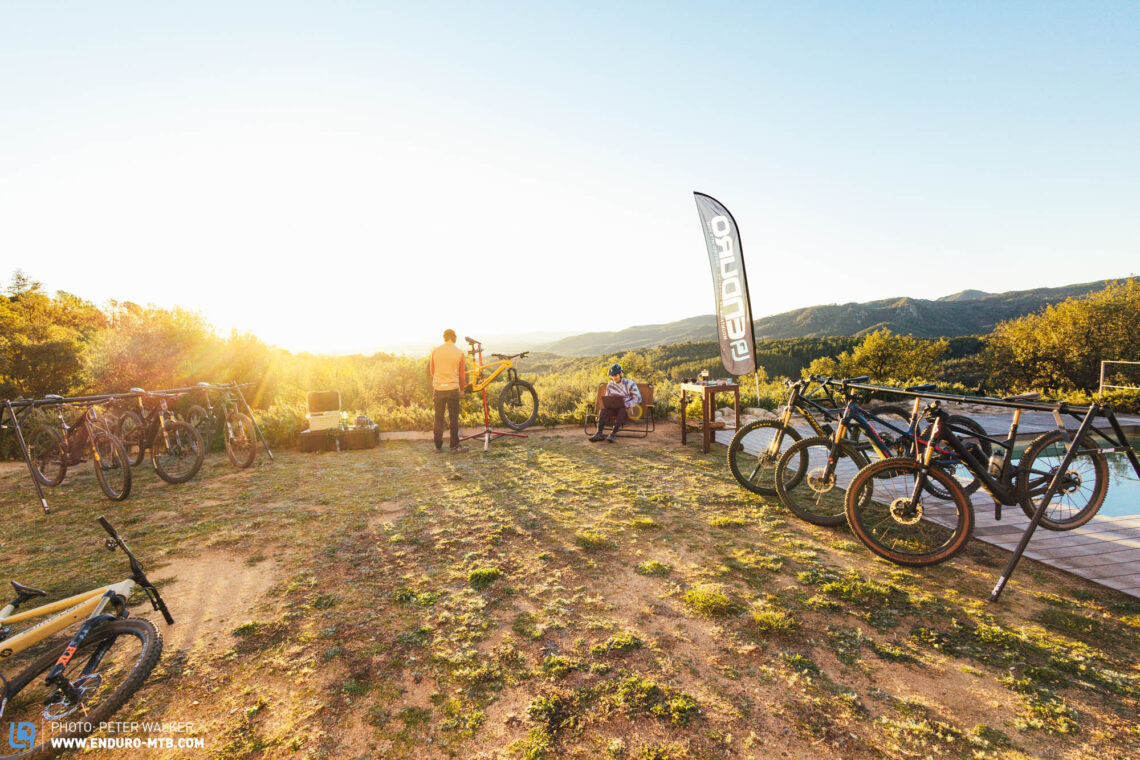
Our Light-eMTB test field – The 8 hottest bikes on the market
For our Light-eMTB group test, we included 8 of the hottest bikes, all of which have been launched within the last 12 months. They don’t just take very different approaches, but also feature four different motor systems. In the right-hand corner, you’ve got the new Trek Fuel EXe 9.9 XX1 AXS, the SCOTT Lumen eRIDE 900 SL and the SIMPLON Rapcon PMAX TQ, all of which rely on the 50 Nm TQ HPR 50 drive unit. They are powered by a 360 Wh internal battery, which you can pair with a 160 Wh range extender. In the opposite corner are the Pivot Shuttle SL Pro X01, the Haibike LYKE CF SE and the FOCUS JAM² SL 9.9. These rely on the FAZUA Ride 60 motor, which delivers 60 Nm of torque and is powered by a 430 Wh battery. The Orbea Rise M-LTD rolls into the ring as an old dog with a new lick of paint. It’s the only bike on test to rely on the Shimano EP801 motor, though with a reduced output of 60 Nm and bearing the RS suffix. In combination with a large 540 Wh internal battery, the competition has their work cut out. The optional range extender provides an additional 252 Wh, giving it more capacity than any other bike on test. Lastly, we’ve got the Forestal Siryon Diode from Andorra making its debut appearance in our group tests. The small premium brand rely on the 60 Nm EonDrive motor, which was developed in-house and is supplied by Chinese motor specialists BAFANG. It features its own software interface with a touch display and is powered by a 360 Wh battery.
| Bike | Motor system | Power (Nm) | Battery capacity (Wh) | Weight (kg) | Price (€) |
|---|---|---|---|---|---|
| FOCUS JAM² SL 9.9 (Click for review) |
FAZUA Ride 60 | 60 | 430 | 19.4 | € 8,499 |
| Forestal Siryon Diode (Click for review) |
BAFANG EonDrive | 60 | 360 | 19.2 | € 14,899 |
| Haibike LYKE CF SE (Click for review) |
FAZUA Ride 60 | 60 | 430 | 18.6 | € 10,999 |
| Orbea Rise M-LTD (Click for review) |
Shimano EP801-RS | 60 | 540 | 18.8 | € 10,255 |
| Pivot Shuttle SL Pro X01 (Click for review) |
FAZUA Ride 60 | 60 | 430 | 18.7 | € 10,999 |
| SCOTT Lumen eRIDE 900 SL (Click for review) |
TQ HPR 50 | 50 | 360 | 16 | € 15,999 |
| SIMPLON Rapcon Pmax TQ (Click for review) |
TQ HPR 50 | 50 | 360 | 19.4 | € 12,999 |
| Trek Fuel EXe 9.9 XX1 AXS (Click for review) |
TQ HPR 50 | 50 | 360 | 18.9 | € 14,499 |
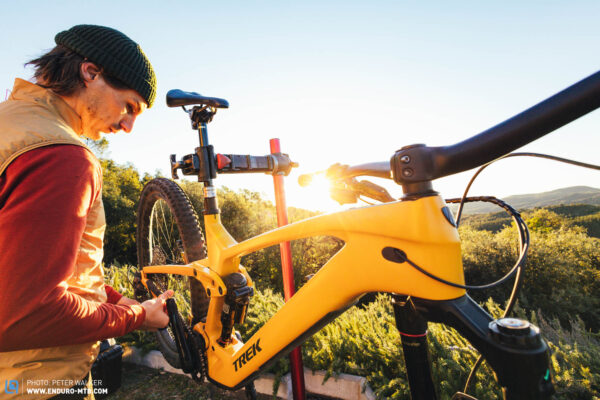

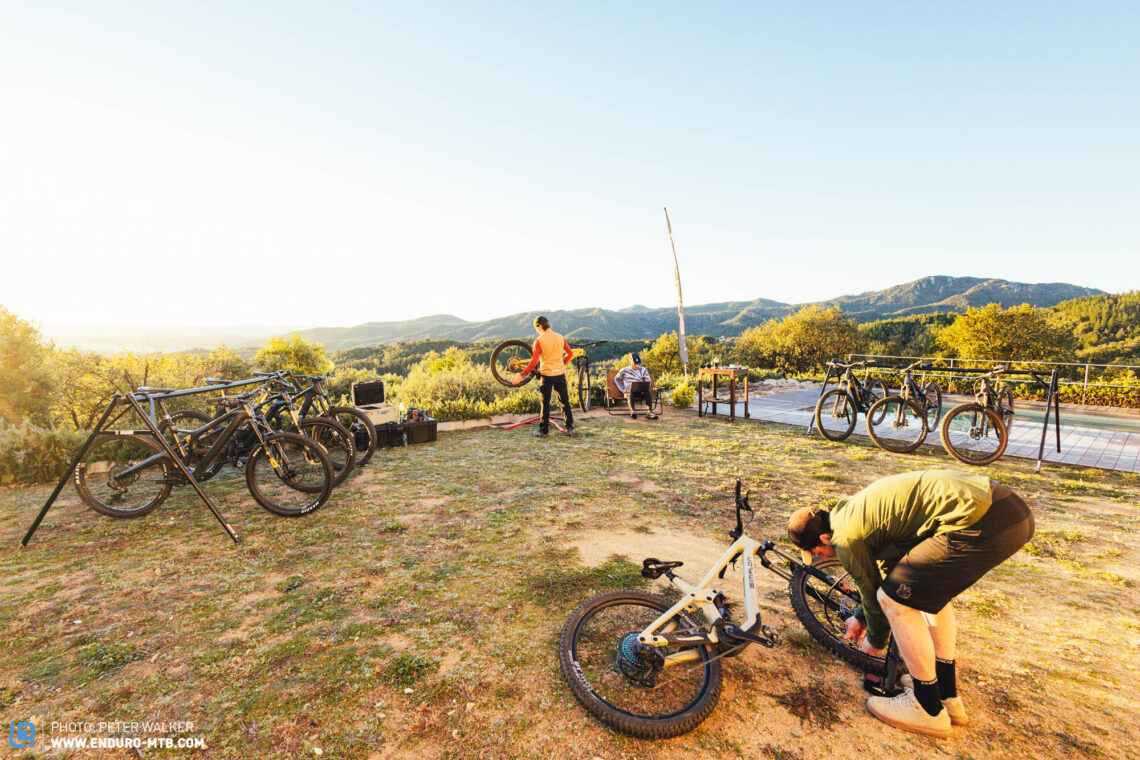
The motor systems of the Light-eMTBs on test, their integration options, and the software at a glance
When you buy an eMTB – or in our case Light-eMTB – you don’t just decide on a bike, but also on a motor system, which has a significant impact on the performance and handling of your bike. While there are many options available and they will continue to grow, it’s good to have an overview and be aware of what you want from your bike. While newly introduced technologies are state-of-the-art, they often still suffer from teething issues. Large established brands usually have a reliable service network in case you have any trouble with your motor, but they often take fewer risks during development than smaller and more agile players, catering to the masses but not necessarily to your individual requirements. The same applies to custom solutions such as display and charging port integration, or even the choice of battery. You can find practical and tailored solutions, though you might have issues with durability or finding spare parts. Manufacturers of bikes, components and motors must work closely together to create a complete package. Thanks to the wide range of products that are now available to bike manufacturers, meeting this requirement is becoming easier and the bikes can be tailored to your needs more and more specifically. Nevertheless, the development of an ebike is vastly more complex than that of its analogue counterpart. The large selection of components and rapidly developing market only serve to complicate matters even more.
That’s why, with eMTBs, you shouldn’t just consider the performance and functionality on the trail, but also trailside repairs and everyday serviceability.
Note: with such rapid development, the market is constantly being flooded with new software updates and accessories such as range extenders. Many of them solve problems or make bikes more versatile, but as the past has shown, they can also create new problems. So, we wrote this article for you based on current information as it stands in March 2023.
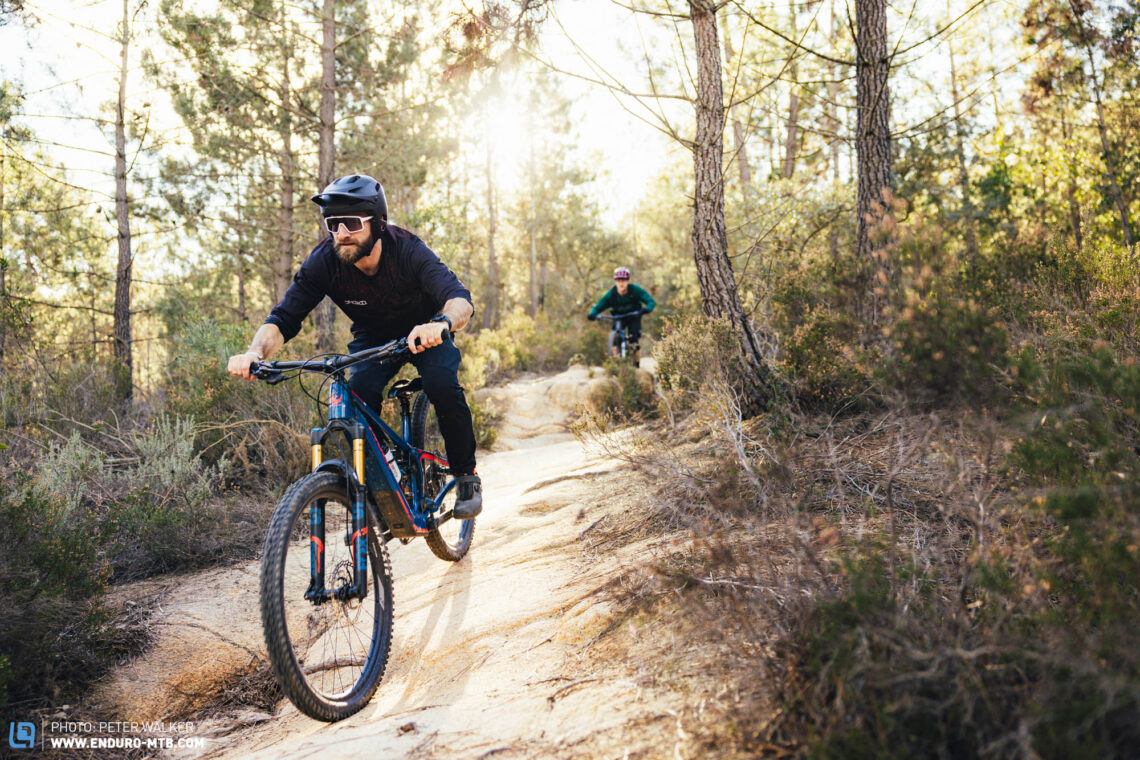
Below, you will find an overview of all the motor systems featured in this group test:
The TQ HPR 50 system
The TQ HPR 50 is the Bavarian tech company’s first minimal assist motor, though not their first ebike motor, and it relies on their patented harmonic pin-ring technology. It was developed in collaboration with Trek, which gave the bike brand the exclusive right to the motor for 3 months before other manufacturers such as SCOTT and SIMPLON were given the green light. At first glance, it seems like Trek use the same display as the competition, but they developed their own software and app. All HPR 50 motors are capable of putting out 50 Nm of torque with a 300-watt peak, and they’re exclusively compatible with the 360 Wh TQ battery. In the case of Trek, the battery can be removed, whereas all other brands have chosen to keep the 1800 g battery firmly integrated in the frame. Due to the compact design of the battery, the down tubes can also be kept nice and slender, making bikes such as the SIMPLON or Trek difficult to distinguish from their analogue siblings and resulting in the most inconspicuous motor system integration to date – the small motor is equally well hidden in the bottom bracket. If you want more range, you can stick the optional 160 Wh range extender in the bottle cage, upping the total battery capacity to 520 Wh.
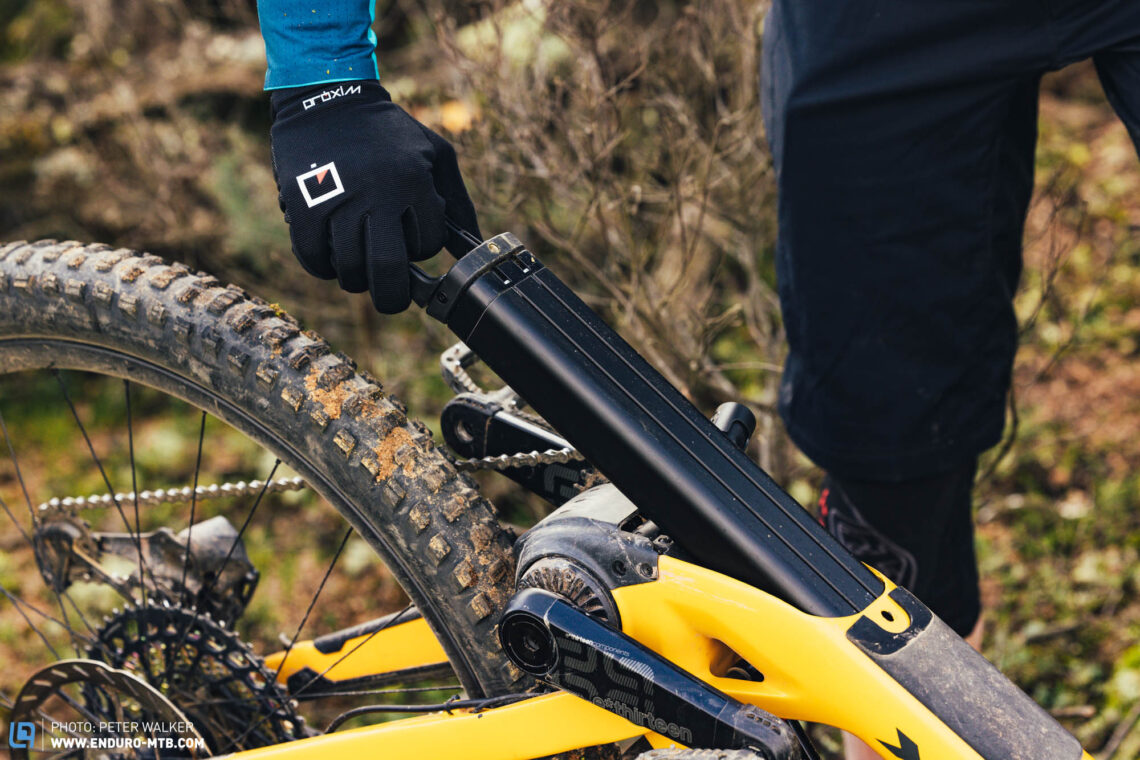

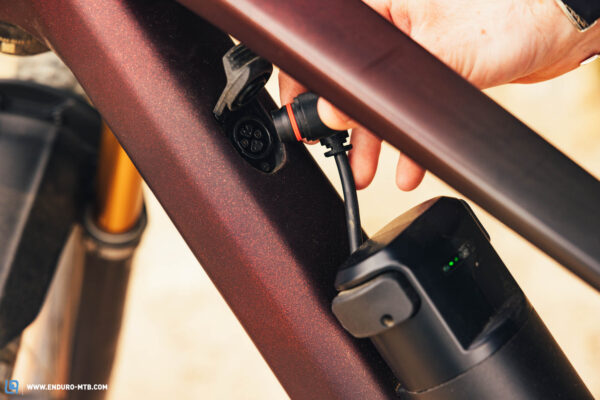
The 2″ TQ display is designed to be integrated into the top tube where it’s inconspicuous but clearly visible. It uses monochrome dots and rings to indicate the chosen support level, which isn’t very intuitive at first. The battery status is displayed via 10 small bars, each representing 10% charge. By double clicking on the button below the display, you can scroll through various views, or switch the system on or off. You have the following views to choose from:
- current speed in km/h
- battery level in percent
- remaining range in the current support level
- current power output of the rider and motor in watts
The system can be controlled via a small remote, which is always attached to the left side of the handlebar. It is very unobtrusive and intuitive to use with just two buttons. It will let you choose the support mode, activate the walk mode, or turn off the assistance altogether. The remote has a pleasant feel and ergonomics due to its rubberised coating, and it provides good feedback thanks to a distinct click. You can also adjust the motor settings and access more data via the TQ app.
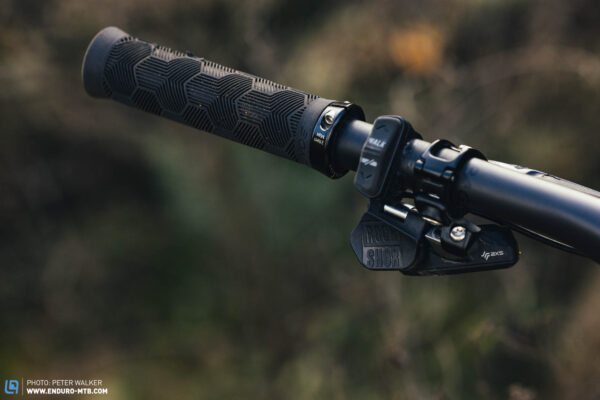
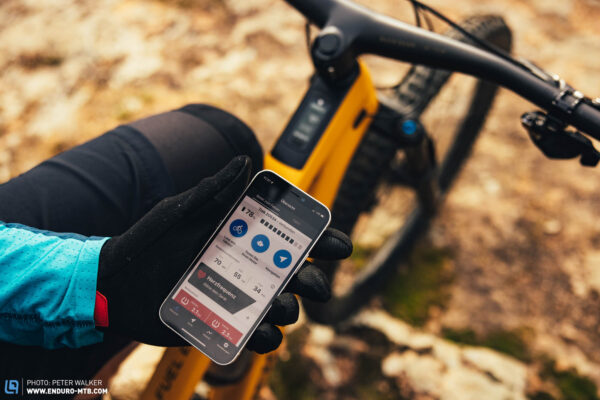
Trek, on the other hand, have integrated these functions into their own app, which also gives you suggestions for the suspension setup, lets you connect to third-party sensors like the TyreWiz via Bluetooth, and displays the range on a map. All in one – cool! The display of the Trek is a bit more intuitive, too, showing you the support levels with 3 large bars and the battery level in %. You can also switch the view to see your average speed and remaining range, with the range displayed in minutes or kilometres.
You have three support levels to choose from on the trail, ECO, MID and HIGH, and there’s a walk assist mode too. The HPR 50 motor is by far the quietest and most natural feeling in the test field. Due to its slightly lower power output and the inconspicuous way it engages and disengages, it feels more like you’re extremely fit rather than being assisted by an electric motor. It’s only when the support is switched off that you become aware of how much the motor has been helping. To unleash its full power, the motor requires a relatively high cadence, making it more likely that you’ll break into a sweat, but it suits the motor’s character. This makes it better suited to gravel road climbs than technical singletrack ascents, taking the burden out of the uphills when you ride, while still keeping you fit. Compared to the rest of the test field, technical climbs require much more physical effort and conscious gear selection to maintain the required cadence for optimal power delivery. If you’re looking for something that will push you up the mountain without putting in any effort yourself, you won’t like the TQ. However, if you like sweating at least a little on the uphills and want a quiet and natural feeling bike, this might just be the perfect companion. Unfortunately, one display became defective during the test, though it’s super easy to replace once you can track down a spare.
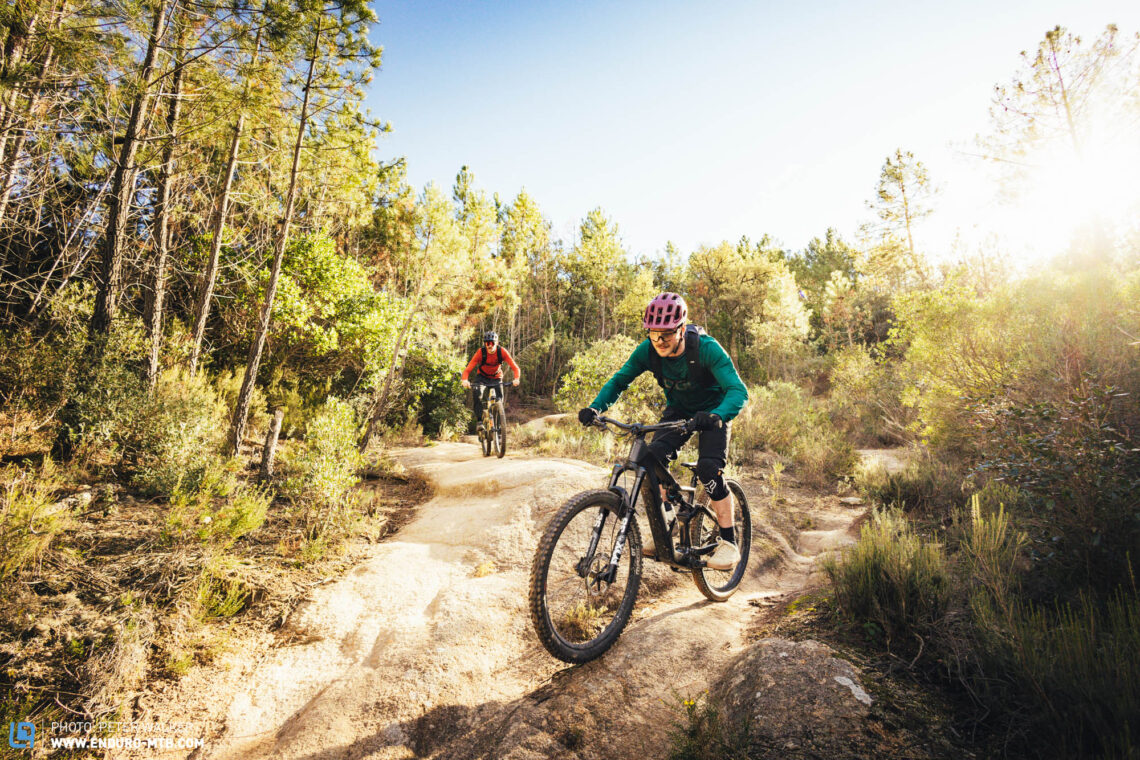
The FAZUA Ride 60 system
The FAZUA Ride 60 is the second minimal assist motor to come from the brand. The first generation was introduced in 2017 and it could be removed from the bike as a complete unit containing the battery and motor. FAZUA chose a different approach with their latest system, and they increased the power output. As the name suggests, the new Ride 60 delivers 60 Nm of torque, with a peak power of up to 450 watts. FAZUA also rely on their own battery, which can be permanently integrated or removable. It weighs in at 1,960 grams and delivers 430 Wh of capacity. While FAZUA have announced a range extender, it wasn’t yet available at the time of the test. Due to the elongated shape of the motor and the fairly wide battery, many of the bikes on test have a down tube shaped like a hockey stick, easily betraying them as ebikes. Haibike are the only brand that tilt the motor horizontally into the seat tube, allowing for a cleaner integration, though this comes with some compromises of its own.



FAZUA also position their so-called LED Hub in the top tube where it’s clearly visible. It indicates the support level and the battery status with the help of 5 small LEDs. As such, the battery level is divided into 5 large 20% increments, and the different colours of the support modes are difficult to read in direct sunlight. By flipping up the LED hub, you get access to a USB-C charging port, though it only delivers about 1 ampere of power. This isn’t enough to charge your smartphone while riding, but it does keep the battery running longer when using your phone to navigate.
On the left side of the handlebar, you’ll find FAZUA’s Ring Control remote. Unfortunately, it isn’t labelled, and due to the cheap feel and looks, it isn’t on par with the competition. The control is multi-directional: it can be pressed up, down and inwards, towards the stem. This lets you control the support levels and activate the walk or boost mode.
As you’d expect, FAZUA also have an app with which you can configure the support modes. They’ve tried to optimise the user experience here: after an extensive questionnaire, the app will recommend the optimal support mode settings, tailored specifically to the rider. This is great for ebike beginners and all those who couldn’t be bothered wasting their time by playing with the settings! If you don’t trust computers or don’t always ride in the same kind of terrain, you can also configure the support modes yourself and save them as pre-sets. You could save them as “the early bird gets the dirt”, “fetch beer” or “power hour”, for example, and call them up as needed.
For the trail, FAZUA has already taken the creative liberty in naming the three pre-configured support modes: Breeze, River, and Rocket. You can also activate the afterburner, officially called Boost mode, for a quick push when needed. However, it takes a moment to kick in and the duration depends on the battery level and the temperature of the motor. In ideal conditions, you’ll get up to 12 seconds of additional thrust to pass your buddies.
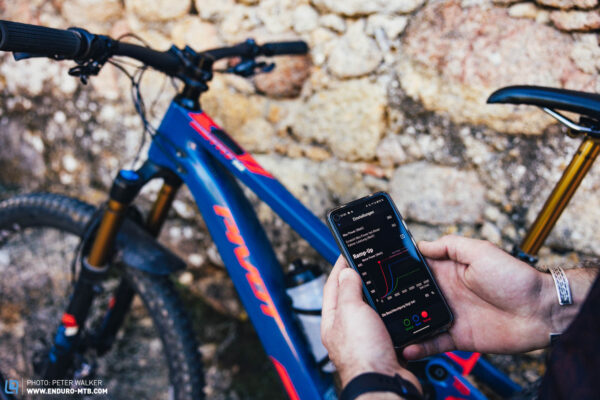
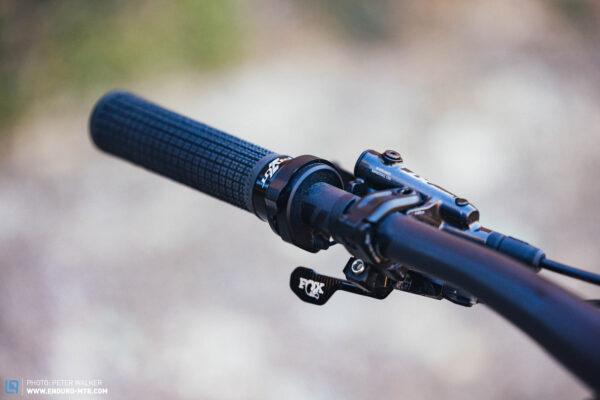
While Breeze and Rocket mode are constant, offering the least and most support respectively, River mode is adaptive, coupled to the pedalling input and adapting the output accordingly. The support kicks in noticeably in Rocket mode, pushing you forward even at low cadence. The FAZUA is powerful enough to let you conquer technical climbs, but the Ride 60 still struggles with a software-related issue, doing a restart after you stop pedalling. So, if you stop pedalling on a climb, the motor keeps assisting briefly and then forces you to pedal on your own for about 1-2 seconds thereafter as it restarts. This can quickly throw you off balance and is very annoying! If you find this to be a problem, you can use the app to make the motor more dynamic, which makes it kick in rather abruptly, but seems to shorten the dip in power. FAZUA are already working on a solution and promise to release a software update that fixes this soon. On the descents, the motor is perfectly quiet, but it is audible when pedalling and resembles the Shimano EP8 motor in terms of sound characteristics. Only the BAFANG motor in the Forestal is louder. The character of the FAZUA Ride 60 is much closer to a full-power system and can make easy work of the climbs. Active riders also get their money’s worth, as long they don’t spend too much time on technical climbs, because the above-mentioned software issue can get frustrating. Besides that, we encountered several instances during our tests where the bikes didn’t switch on. In this case, it helps to shake the bike, recharge the battery, unplug it, or wait… Unfortunately, one of the bikes remained defective.
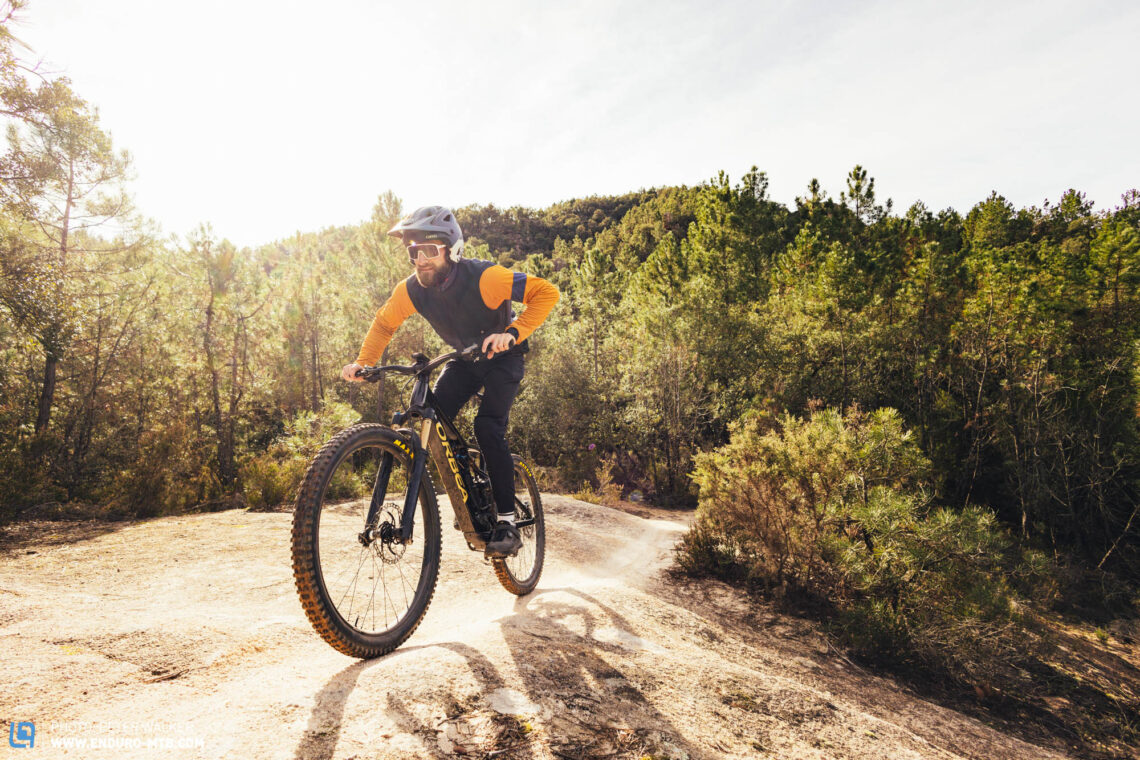
The Shimano EP801 RS system
The Shimano EP801 is an EP8 motor with slightly modified hard- and software. The 01 suffix provides for a wider cadence range in which the motor offers support and a FINE TUNE mode to adapt it to your needs. You also get a wider selection of remotes and it’s compatible with Di2 groupsets. However, the RS addition is Orbea’s and – contrary to what most riders think – means that the motor’s power output has been throttled from 85 to 60 Nm. Since Shimano allow third-party batteries, Orbea can offer the Rise with a 360 or 540 Wh internal battery. As with TQ, you can also store a range extender with a generous 252 Wh in the bottle cage. Since the EP801 is also used on full-power eMTBs and is only restricted by the software, it’s the largest motor on test and thus also limits the bike’s discreet looks.
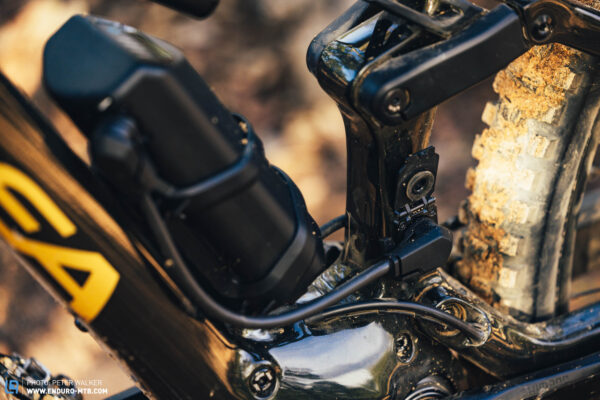

In our case, there was no display on the bike, with battery and support mode information instead displayed via the small remote, which is located on the left side of the handlebar. There’s an LED that uses 5 different colours to indicate the 3 support modes, walk mode, or an error code. A second LED flashes red or green, or lights up permanently, thereby showing you the battery status. However, it’s somewhat confusing and thus serves more as an emergency signal. A flashing red light means that it’s time to head home. Of course, the remote can also shift the support modes up and down, activate walk mode, and switch the system on or off. If this is too minimalistic for you or you want a different remote, Shimano give you many options to choose from to equip your bike with displays and the like.
With the E-TUBE PROJECT app from Shimano, you can create different profiles for the basic eco, trail and boost modes. With the FINE TUNE function of the EP801, you can activate up to 15 additional support modes. The app also gives you the battery status in percentage points, in case you need more detailed information than that offered by the LED on the remote.
On the trail, you can switch between eco, trail and boost, or the additional support modes. Even in the highest setting, the EP801 remains easy to modulate and allows you to pull away safely even in tricky conditions. The Shimano still delivers a decent amount of power at a low cadence, showing what a wide range it has. This makes easy work of the climbs even after a long day in the saddle. Technical ascents are no problem either, thanks to the power and characteristics of the reliable Shimano motor. The EP801 is relatively quiet when it isn’t under strain, but it trumps the FAZUA motor when it’s working hard – only the BAFANG is louder. A big drawback is the metallic rattling noise that it makes on the descents, which the Shimano EP8 motors are known to do. If you’re looking for a reliable motor that’s easy to modulate, provides a lot of customisation options, and has a large service network, the EP801 is a faithful companion. It provides enough power for technical climbs and relaxed ascents, though it can’t be integrated into the bike as inconspicuously as the competition in this test field.

The BAFANG EonDrive system
The BAFANG EonDrive motor in the Forestal is rather unique. It’s manufactured by BAFANG, but a significant part of the development was carried out by Forestal, combining it with in-house accessories and software. It’s a daring and impressive achievement when you consider that it’s the debut product of the fledgling Andorran bike brand. The EonDrive motor delivers 60 Nm of torque and is powered by a 360 Wh BAFANG battery. Forestal have announced that they’ll be releasing a 250 Wh range extender, though it had yet to be released at the time of testing. The Forestal is the only bike on test with a 3.2″ touch display, which is beautifully integrated into the top tube. The display sensitivity can’t keep up with the level of modern smartphones, but it works surprisingly well and is intuitive to use. Just don’t get mud or water on the display, as that seems to confuse it, going back and forth until you wipe it clean. It’s best to lock the display before you ride to prevent that from happening. The display provides an immense wealth of beautifully displayed metrics such as the battery level percentage, distance travelled, altitude difference and the current time. There is a large GPS map too, and you can record your rides thanks to the GPS antenna that Forestal have disguised as a stem spacer, which doubles as anti-theft protection – cool!

To use many of these features, you’ll need to connect your bike to the Forestal app. It provides additional information about the motor, battery, and your activities. You can also see the location of your bike and get in touch with Forestal. No other bike on test can match the extensive functions of the Forestal system.
Like the others, the remote can be found on the left-hand side of the handlebar, where you’ll also find an additional battery indicator in 25 % increments. The remote has two buttons to shift between support modes, and a third button to switch the bike on or off, or activate walk mode. Unfortunately, the rubber buttons provide zero haptic feedback, and the cheap-looking remote seems misplaced on the otherwise premium looking Forestal.
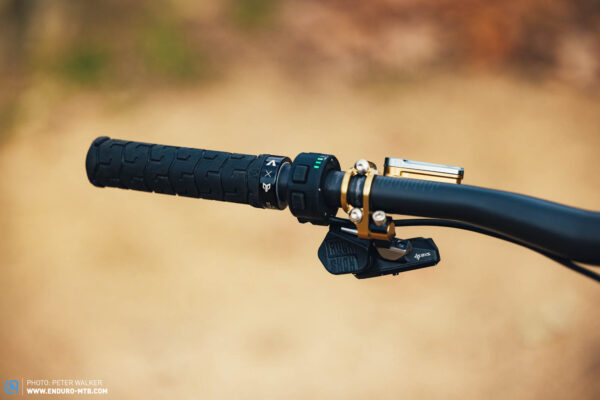

On the trail, the BAFANG system offers four different levels of support and a walk mode. However, the BAFANG turns out to be the loudest motor on test, almost whistling like a turbo when put under strain. But it also offers the most assistance, engaging quite aggressively when pulling away. However, the assistance provided is heavily dependent on the cadence. The motor can’t unleash its full power at cadences below 60 rpm or above 100 rpm. Fortunately, the display shows you your cadence, which takes out the guesswork and helps you stay in the optimal range. Within that range, the motor pushes you along even when the climbs get technical, though you get the feeling that the motor’s output gradually lessens the longer the climb and you have to keep adding more input of your own to make it to the summit. The duration that the motor keeps assisting after you stop pedalling is dynamic. This means that the harder you pedal, the longer the delay. Although this results in natural feeling assistance, it can be a hindrance on technical climbs, as you often need the motor to keep pushing even if you’ve only put in a light pedal stroke. The motor is silent on the descents and there’s enough free movement in the cranks to avoid any unwanted thrust. We didn’t run into any problems with the BAFANG system, but the after sales service could be an issue considering the very small production run and the wealth of custom solutions. It also has a very high battery consumption, draining the battery noticeably simply from being switched on.
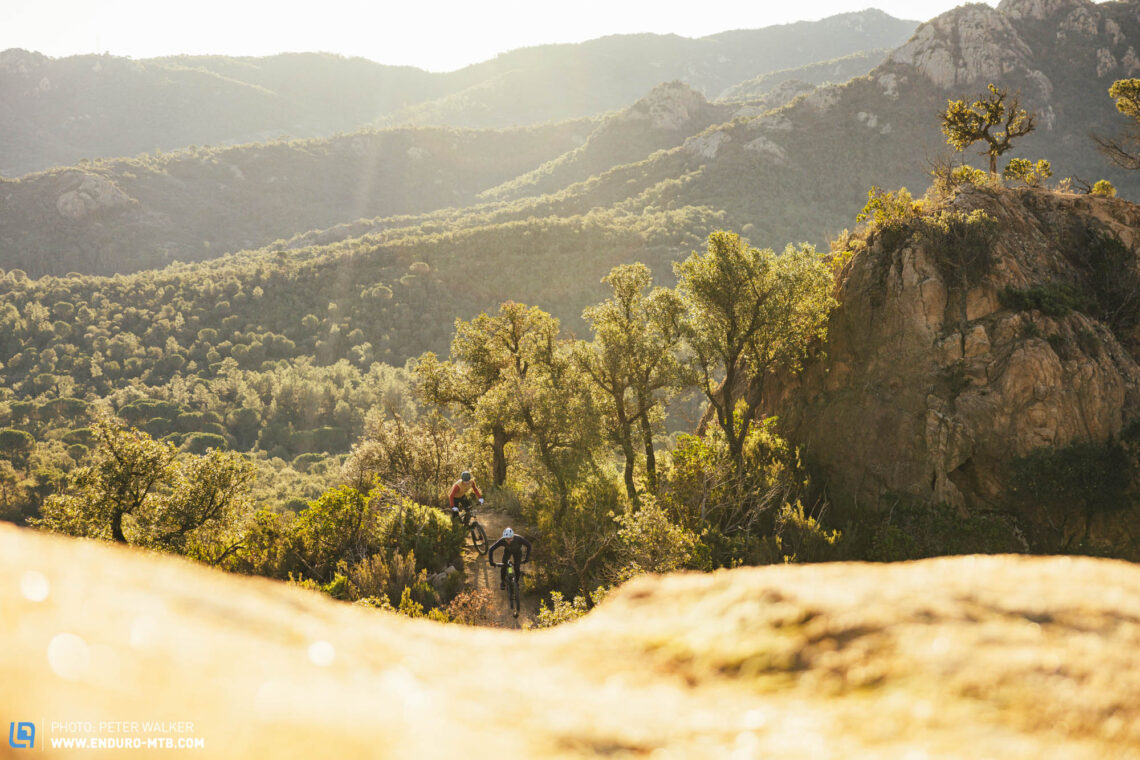
How and where did we test the Light-eMTBs?
It comes as no surprise that we weren’t crazy about the idea of testing 8 Light-eMTBs in January, sliding around in the freezing mud of the German winter. To make matters worse, we did it while conducting the biggest E-MOUNTAINBIKE group test of all time, putting 30 eMTBs head to head. This allowed us to make direct comparisons between all the relevant systems, gaining a lot of insights we wouldn’t have otherwise. Due to the different target group and requirements of ENDURO’s readers, we then took the 8 Light-eMTBs out of the test field and reviewed them separately.
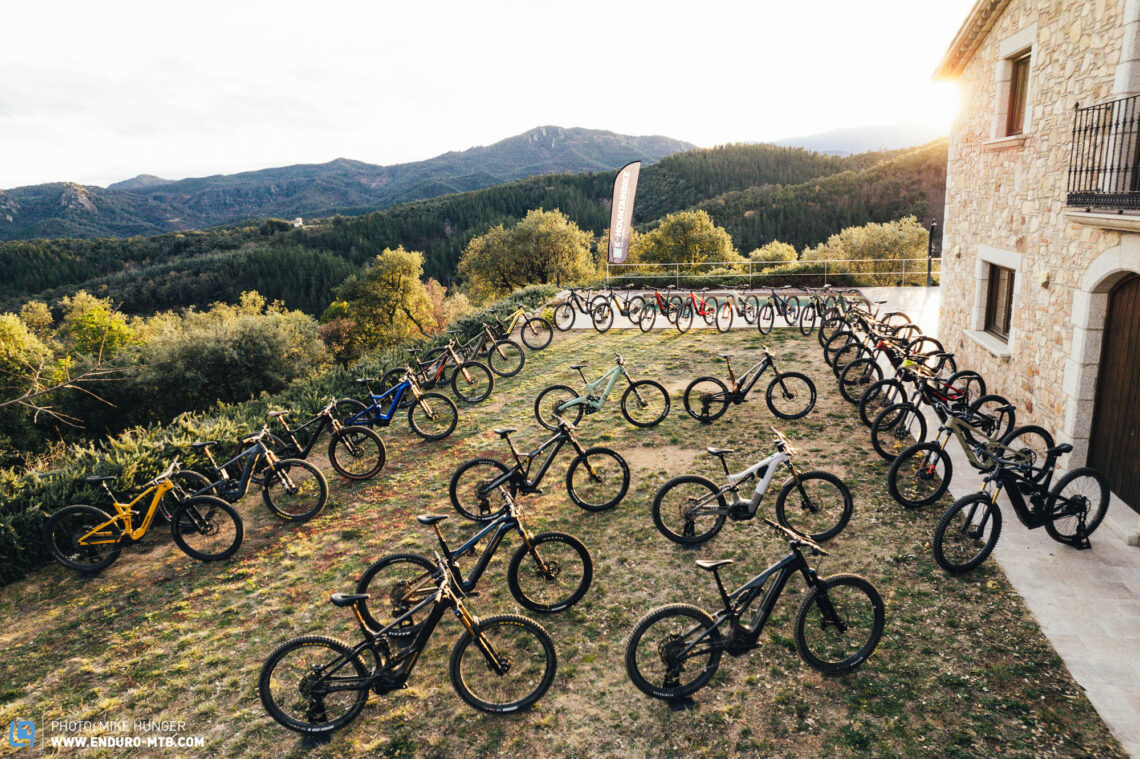
Fortunately, it all took place in the sunny south. The still relatively unknown Spanish town of Santa Coloma de Farners – which is about an hour’s drive east of Barcelona – offered the perfect location to put the bikes through their paces with its huge trail centre, and sandy and rocky trails. We successfully dodged the two rainy days – the average January rainfall – and had dry trails throughout. Our test track, a combination of “Dragon Khan” and “La Llosa”, was peppered with sandpaper-like rock slabs, roots, flowing berms, and loose, sandy corners. The climb to the trailhead had a bit of everything from wide gravel roads with huge potholes which, if you accidentally hit one of them, would almost catapult you off the bike, to technical sections that the bikes only just got up. So, if you feel like going somewhere other than Italy for a change and are looking for fine trails without shuttles, you will find everything your heart desires at Santa Coloma de Farners. If that’s not enough, there are two bike parks just a stone’s throw away, and the ticket is cheaper than a shuttle day in Finale ;).
Our test crew

I test more than 100 different bikes each year and have followed the development of Light-eMTBs from day one. Light-eMTBs are perfect after a hard day at work or to spice up my home trails and ride them the other way around without being completely knackered afterwards. The Forestal Siryon really did it for me: it’s got a powerful motor and you can let rip on the descent thanks to the long travel suspension. Practical and futuristic features like the anti-theft protection and touch display are a step in the right direction for future eMTBs.

I’m the only one who works on my bikes, because, as a racer, I must have confidence in my equipment and know how to fix it when things go wrong. To get even more time on the bike, I bought the SIMPLON Rapcon PMAX TQ. It’s ridiculously capable on the descents and offers natural feeling support. The active riding style it demands is great for training without getting too exhausting.
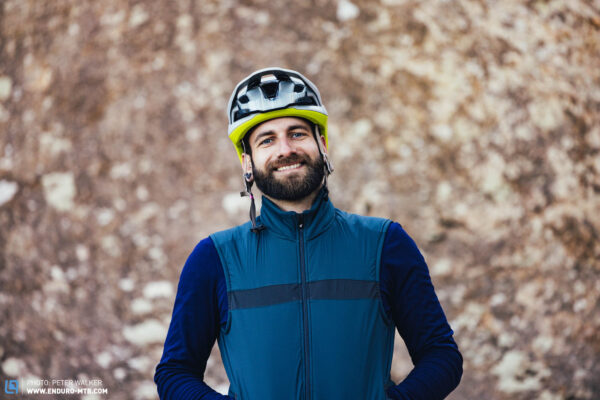
When I’m not in the office, I’m on the road and can usually be found where there’s good weather and sports, whether climbing, skating, or biking. When I’m on the bike, I want to have as much fun as possible. The stiff Pivot Shuttle SL Pro X01 rails the berms like no other and gets my adrenaline pumping. Thanks to the powerful FAZUA motor, I can be back at the trailhead in no time at all. If I don’t feel like doing another lap, it leaves me feeling fresh enough to flash a boulder before the sun sets.
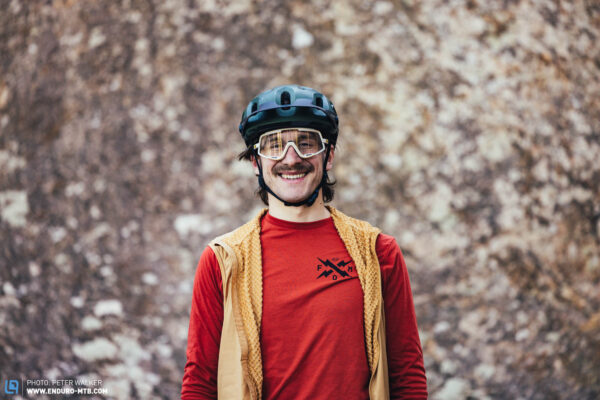
After getting up, I first hop on to my yoga mat and then start the day with a balanced breakfast. Coffee and unhealthy food are a no-go for me, and when I get on my bike, I want a solid all-rounder that lets me explore the trails with no stress. The Trek Fuel EXe 9.9 XX1 AXS is easy to ride and performs reliably. I can also increase the range with the range extender, so I can ride even more trails.

I am new to the ENDURO team and even though I’ve been riding mountain bikes for several years, Light-eMTBs are a new world to me. The FOCUS JAM² SL 9.9 doesn’t break the bank and it’s super easy to ride. It’s the perfect introduction to eMTBs, and because I’m smart and bought two batteries, I can quickly replace them and shred all day long.
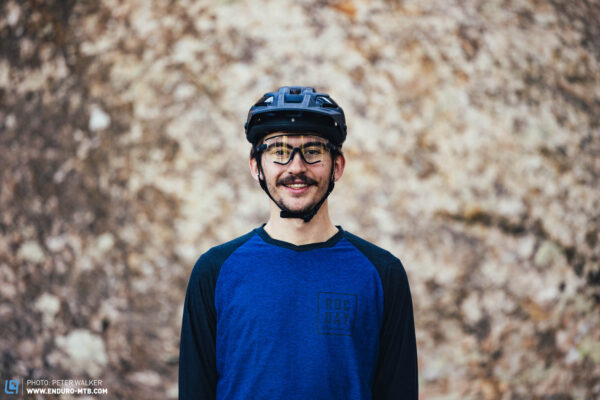
I’ve been working in a local bike shop for as long as I can remember and have solved my fair share of bike problems. The concept of the Orbea where you can adapt the bike to your personal preferences and still buy it from a local dealer is the perfect solution for me. In addition, the Orbea Rise M-LTD has a Shimano motor and I can easily get support in case of problems thanks to their large service network.
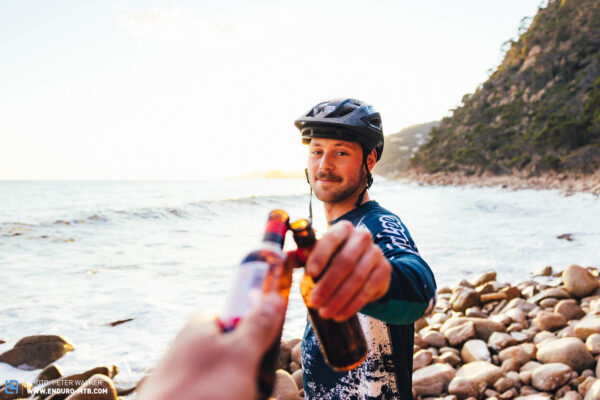
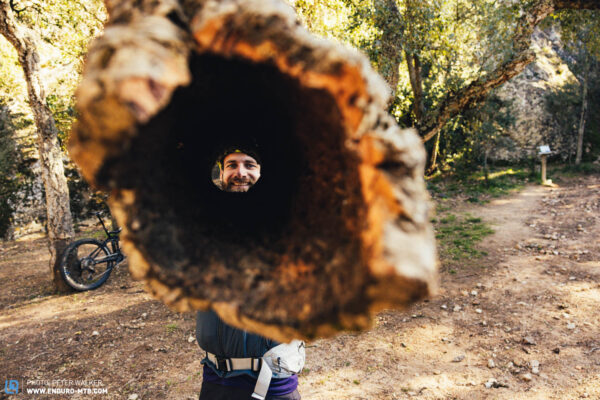

Our Light-eMTB group test in numbers
Things that went wrong during our tests:
- 1 derailleur hanger got torn off
- 1 chain broke
- 3 tires got punctured
- 1 Shimano brake lever broke
- 3 FAZUA bikes had difficulties starting up
- 1 FAZUA bike was defective
- 1 TQ display failed
- 1 skid plate broke
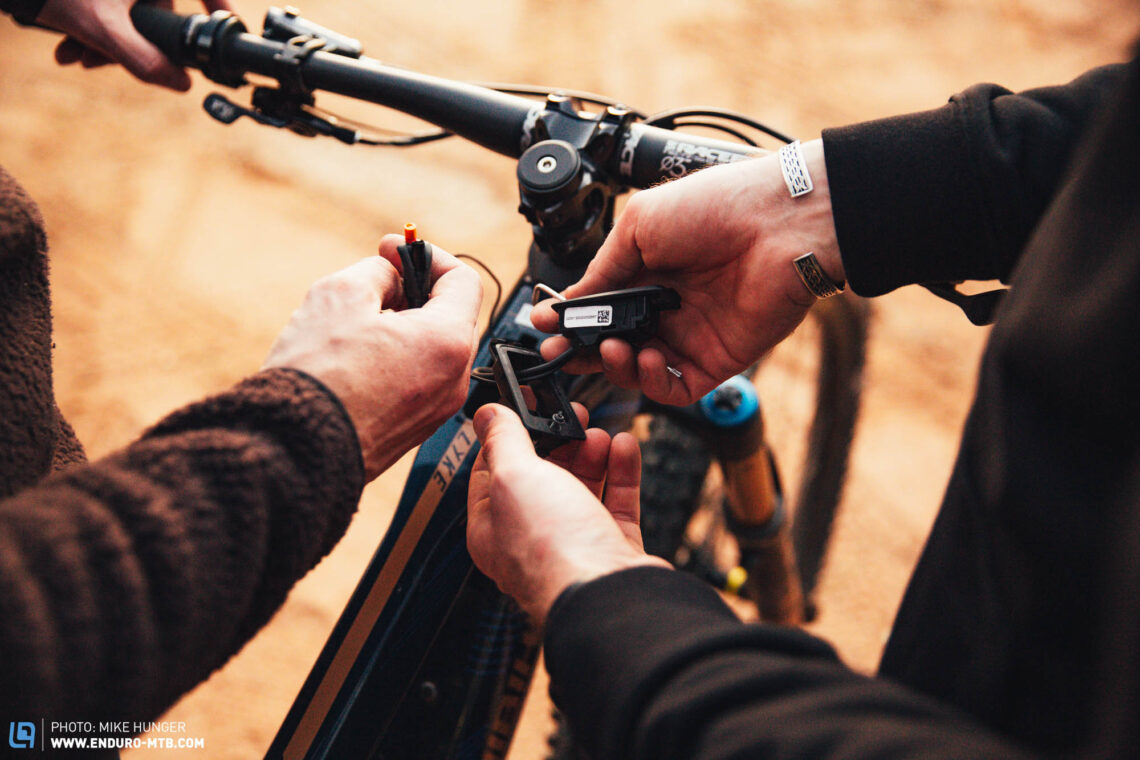
Our test crew had:
- 5 crashes
- 7 near death experiences
- 6 kg Clif Bars
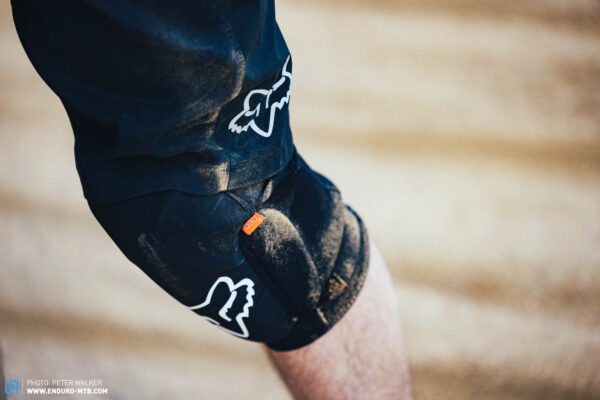
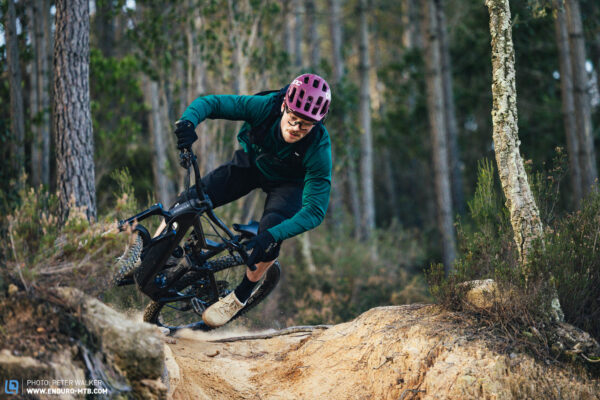
The Light-eMTBs on test:
- 8 bikes in the test field
- € 12.394 average price
- that would be 688 crates of our favourite regional beer (Wulle)
- € 15.999: the most expensive bike on test, the SCOTT Lumen eRIDE 900 SL
- € 8.499: the most affordable bike on test, the FOCUS JAM² SL 9.9
- all bikes roll on 29″ wheels
- the bikes weigh 18,6 kg on average
- the lightest bike weighs 16,0 kg and is the most expensive bike
- the heaviest bike weighs 19,4 kg and is the most affordable bike
- the smallest battery is 360 Wh
- the biggest battery is 540 Wh

What should you look for when buying a Light-eMTB?
Before you pillage your bank account to call yourself the proud owner of a Light-eMTB only to realise that you made the wrong choice, you should ask yourself a few essential questions. Most bikes can only live up to their full potential if they’re used as intended and, by extension, you will only be happy if you find a bike that suits you and your riding style.
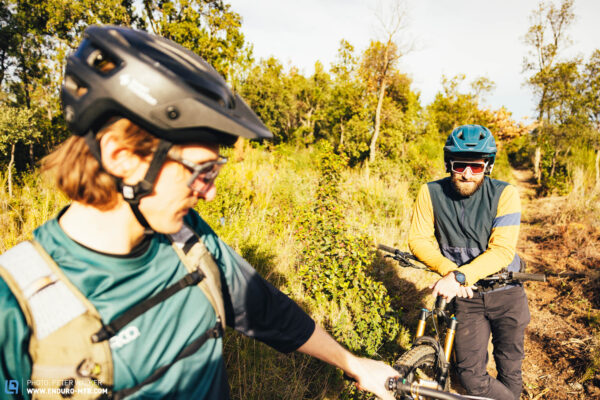

It all boils down to overall concept
Many ebike buyers want to know which is the right or best motor, but it’s like the 29” vs 27.5” wheel size debate (just slightly more complex): the best motor is only as good as the eMTB it’s installed in. Conversely, the eMTB is only as good as the way the motor supports and complements the character of the bike. Compared to analogue mountain bikes, this makes matters much more complex, because there are more factors – like the integration of the battery and motor, and the weight distribution of heavy components – that must work in harmony to offer a coherent package with characteristics that seem contradictory.
New possibilities – even enduro riders eventually get old
Exhausted after a long day at work? Pressed for time? Riding with your buddies on the weekend, but they’re all on eMTBs? Or want to take your kids for a ride in the trailer without giving up on the first climb? The latest generation of Light-eMTBs can be the answer while still offering full-on trail fun without sacrificing performance.
Note: Light-eMTBs don’t necessarily have less range!
Just because Light-eMTBs typically have a smaller battery doesn’t mean that they have less range than full power eMTBs. You must always consider the battery capacity in relation to the power of the motor, i.e. its consumption. You may get just as far or even further, though with less support, so it’ll take longer or more effort on your part.
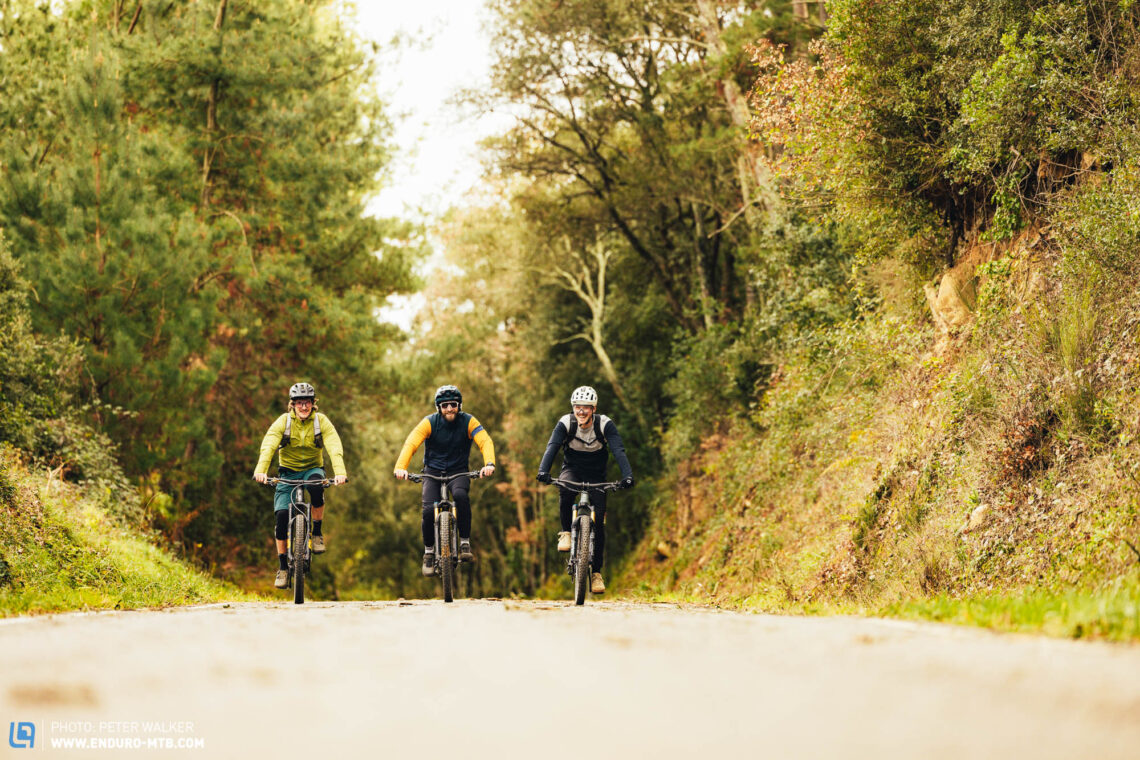
What to ask before buying a Light-eMTB
Do I tend to ride in a group with analogue mountain bikes?
Then pretty much every Light-eMTB or motor system is suitable for you because you can always go slower. In most cases, the eco mode can also be individually configured and you can adjust the amount of support according to your needs, or you can turn off the support entirely. The range shouldn’t be a limiting factor either when using minimal support and if you have extremely fit colleagues, most Light-eMTBs have the option of a range extender. From our experience, you should easily keep up in the lowest and medium support modes and still have enough reserves for the occasional overtaking manoeuvre.
Do I tend to ride in a group with full-power eMTBs?
If you regularly go riding in the company of full-power eMTBs, then the power, i.e. torque output of your motor power will be a decisive factor for you. You don’t want to be the one holding everyone up! Roughly speaking, the highest support mode of a Light-eMTB corresponds to about the middle support mode of a full-power ebike, and so there isn’t much you can do if your buddies decide to shift up a gear. However, if they stay in the lowest mode, you shouldn’t have any problems keeping up, even with bikes that rely on a TQ system. But remember: more power also consumes more battery. That said, the Orbea Rise has a battery capacity of 792 Wh with the range extender, which is more than most full-power eMTBs. In this case, your buddies are more likely to get range anxiety, even if you might have to put in a little more physical effort.
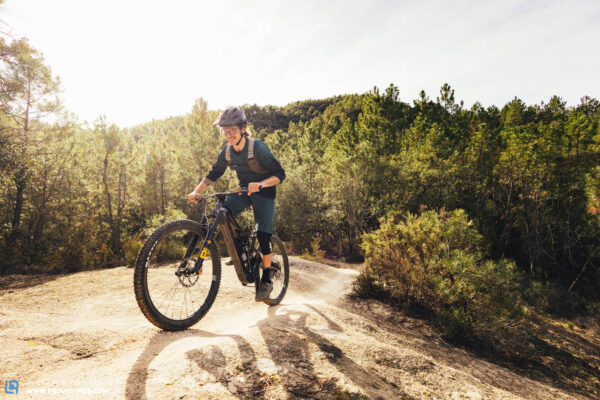

How much effort do you want to put in?
If you want the feeling of simply being pushed up the mountain that you get with an eMTB, a Light-eMTB is not what you’re looking for. Nevertheless, there are Light-eMTB motor systems that will get you to the summit in a more relaxed manner than others, though it’s not something that everyone wants. The TQ HPR 50 can generate just 50 Nm of torque and it requires a fairly high cadence to do so. It is more strenuous, but it also helps you stay fit without having to torment yourself up the steep sections. If you’re looking for a Light-eMTB yet want to exert yourself as little as possible, the systems from Shimano, FAZUA or BAFANG are the better option.
How much battery capacity do you really need?
If you usually only ride short laps with minimal support, large batteries only mean extra weight, which usually comes at the cost of trail performance. Furthermore, lightweight riders consume significantly less battery, and the topography of the trail also has a major influence on range. On the other hand, if you love nothing more than gaining altitude or riding long distances, you’ll probably do well with a big battery capacity. Tackling technical climbs or using a high support mode naturally drains the battery quite a lot quicker. Fortunately, most manufacturers already offer range extenders, or at least have one in the development pipeline. That allows you to adjust your capacity depending on the planned route. Removable batteries, such as those found on the FOCUS or Trek are an option, too. You’ll just have to budget for the cost of a spare battery, and go back to the car to switch out batteries.
What additional features should your Light-eMTB have?
The possibilities are endless as most manufacturers offer countless options for displays, remotes, or additional accessories at the time of purchase. But what do you really need? What is helpful and what is simply unnecessary? The good thing is that you can retrofit most accessories at a later stage and there is a constant stream of software updates and extensions entering the market. Before buying, however, you should still have an idea of what you want from your display, whether you need a navigation function, or if a flashing LED is sufficient. An integrated light or GPS tracker doesn’t hurt and doesn’t limit the bike’s performance on the trail, it just keeps you and your bike a whole lot safer, regardless of whether that’s on your daily commute to and from work or during a post-ride beer on the Ligurian coast. So, when buying, be aware of what you need or might want to retrofit in the future and find out about compatible options.
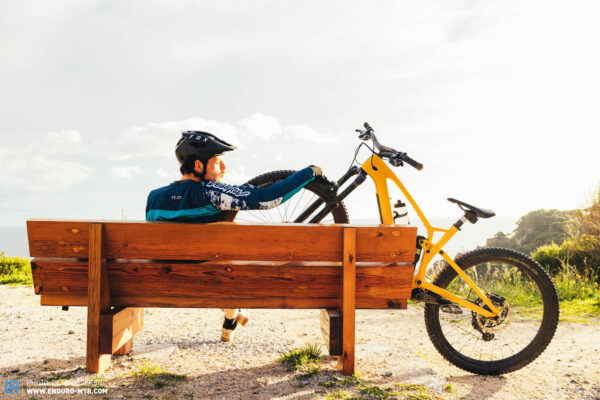
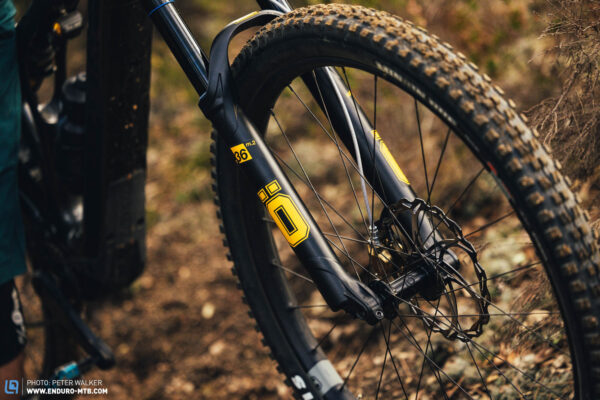
What should you consider when handling a Light-eMTB?
The development of Light-eMTBs often goes hand in hand with certain compromises to make the bike as light, clean and slender as possible. This isn’t necessarily a bad thing, but it can make things tricky for you depending on the situation. For example, if you don’t have a power outlet where you park your bike, you’ll want to be able to remove the battery for charging. Otherwise, you’ll need to park your bike in your living room or next to your desk at work to keep it charged. Conversely, it’s annoying if you must remove the battery after each ride to charge it even though you’ve got a power outlet right there. The trend of routing the cables through the headset creates a clean look, but also makes servicing the bike a whole lot more frustrating. If you’re an inexperienced or impatient mechanic, you should get a bike with classic internal cable routing with ports in the top or down tube, or good old external cables.
What should you consider regarding the components of a Light-eMTB?
There’s no such thing as the perfect, one-size-fits-all build, but some components have a much greater influence on your bike’s performance on the trail and above all on your safety. The added weight of large brake rotors is negligible, and they improve the reliability and power of your brakes enormously. In this instance, the following applies: better to go for big brake rotors than top-of-the-range brakes intended to save weight. The suspension has a huge influence on your bike’s performance on the trail, on long-distance comfort, and climbing efficiency. You don’t need the golden Kashima coating, but you should pay attention to the damping technology used. We recommend the GRIP2 damper for FOX forks, or the Charger 2.1 or Charger 3.0 damper for RockShox models. With the shock, a piggy-back reservoir is a useful feature to get the best performance from the rear end. At the risk of repeating ourselves, we must emphasise that any component can only work as well as it does in combination with the bike as a whole.
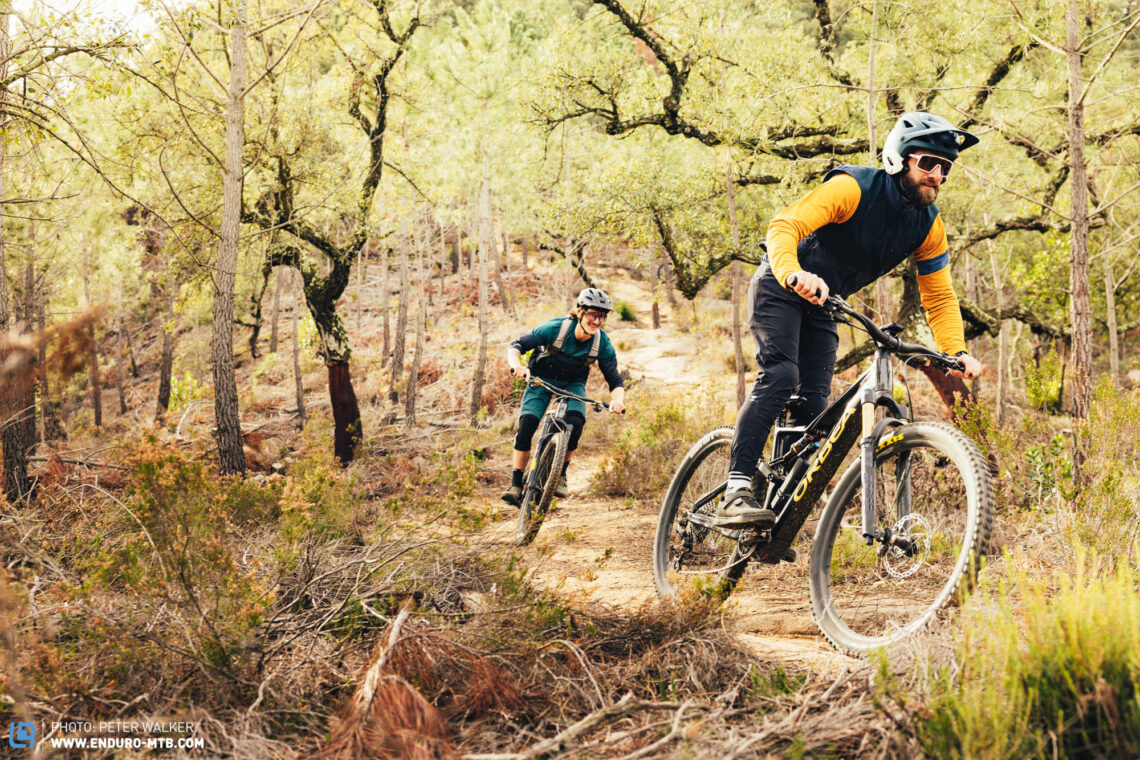
The tops and flops of our Light-eMTB group test
Tops

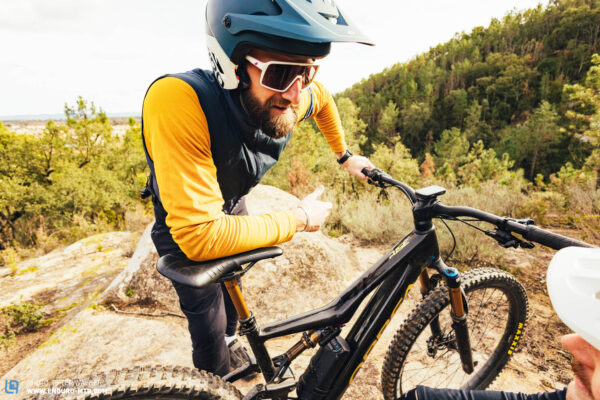
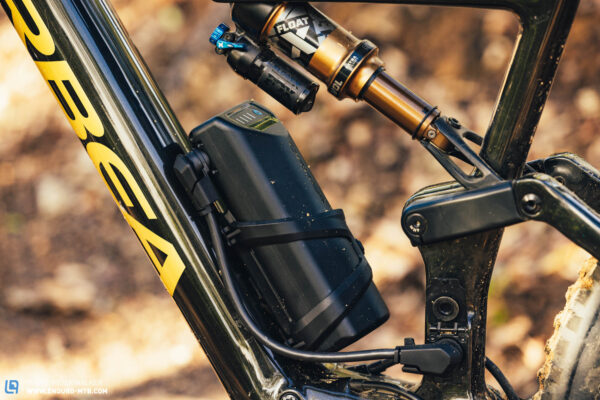
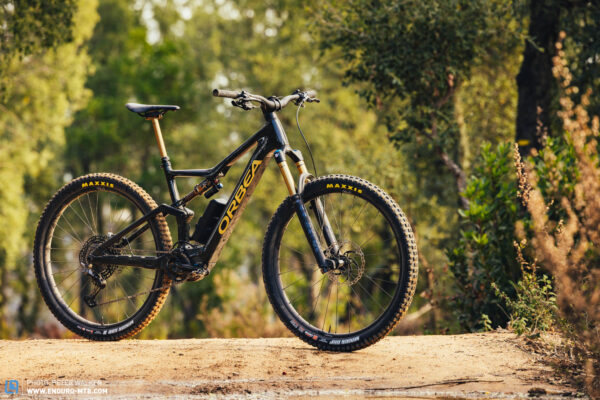
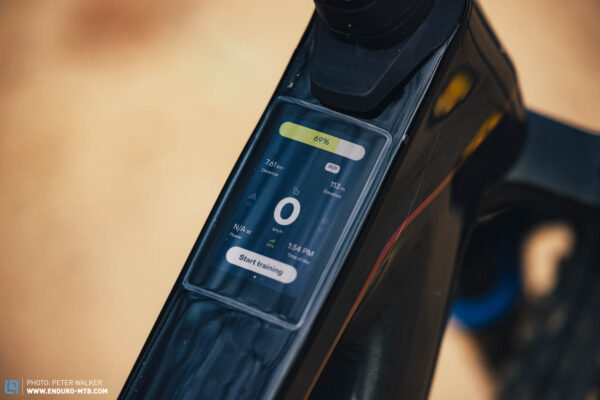
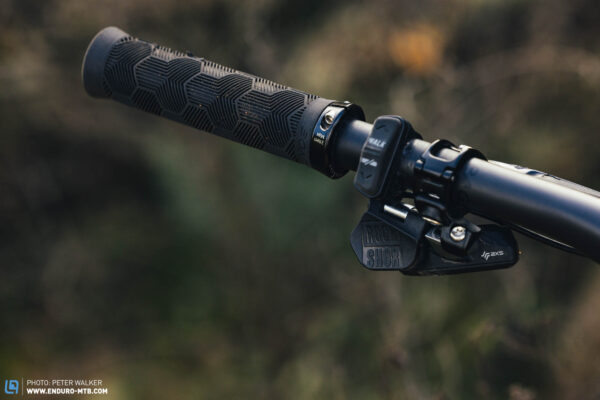
Flops
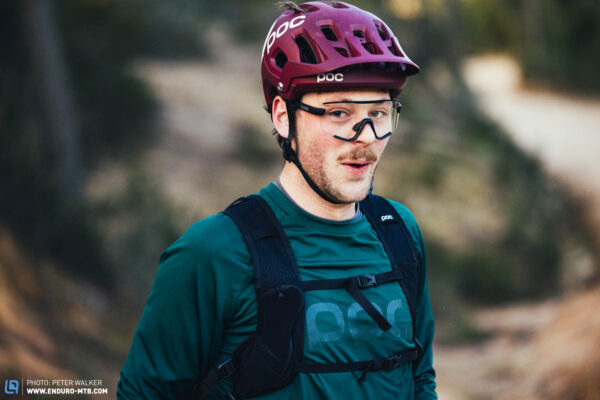
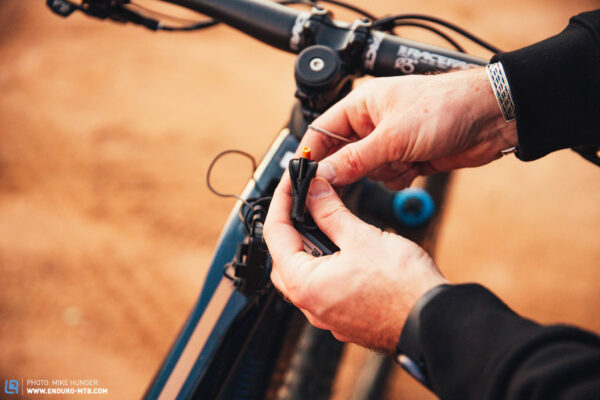
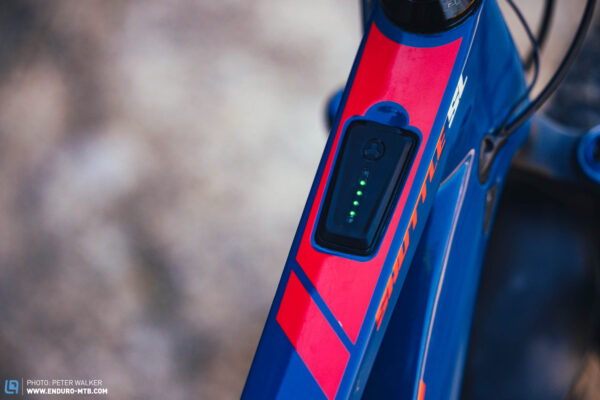

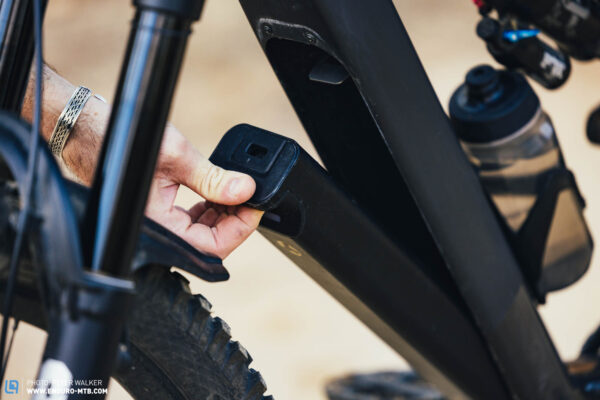

An overview of the Light-eMTB test field and the winners
The latest generation of Light-eMTBs ticks many of the right boxes, benefiting from the expertise gained by bike and motor manufacturers through the development of full-power ebikes. Our group test also shows that the same motor systems can be integrated into a bike in very different ways. And while the motor system is an important component, it’s ultimately up to the bike manufacturers to define the intended use and character of the bike, despite having almost identical key metrics – the differences are huge! Considering the status quo, it’s clear that the new systems from TQ and especially FAZUA still have bugs to iron out, especially on the software side, with over half of the test field struggling with motor related problems at some point during the test. For the end user, that means paying a fortune for a bike that might not work as it should. It’s a common early adopter problem! Fortunately, we live in a time when you can easily solve problems via software updates. For a better overview, we’ve made a list of all the bikes on test and their characteristics below.
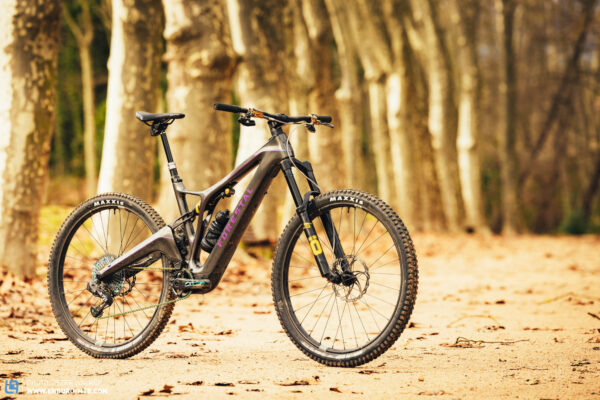

The Forestal Siryon Diode could be considered the most futuristic Light-eMTB on test. The Andorran start-up have tackled a mammoth project for their first bike, demonstrating a level of development that you don’t even see from the world’s biggest bike brands. Chapeau! They’ve shown what the future of ebikes can hold. A touch display, which was developed entirely in-house and is beautifully integrated into the top tube; an app with an extensive range of functions including theft protection via a hidden GPS antenna in the stem spacer; and a motor that Forestal played a large role in developing. Moreover, the Siryon is a force to be reckoned with on the trail – it’s one of the most capable bikes on test. Unfortunately, it also had an extremely high battery consumption, the loudest motor on test, and we’ve got a lot of unanswered questions when it comes to the after sales service.
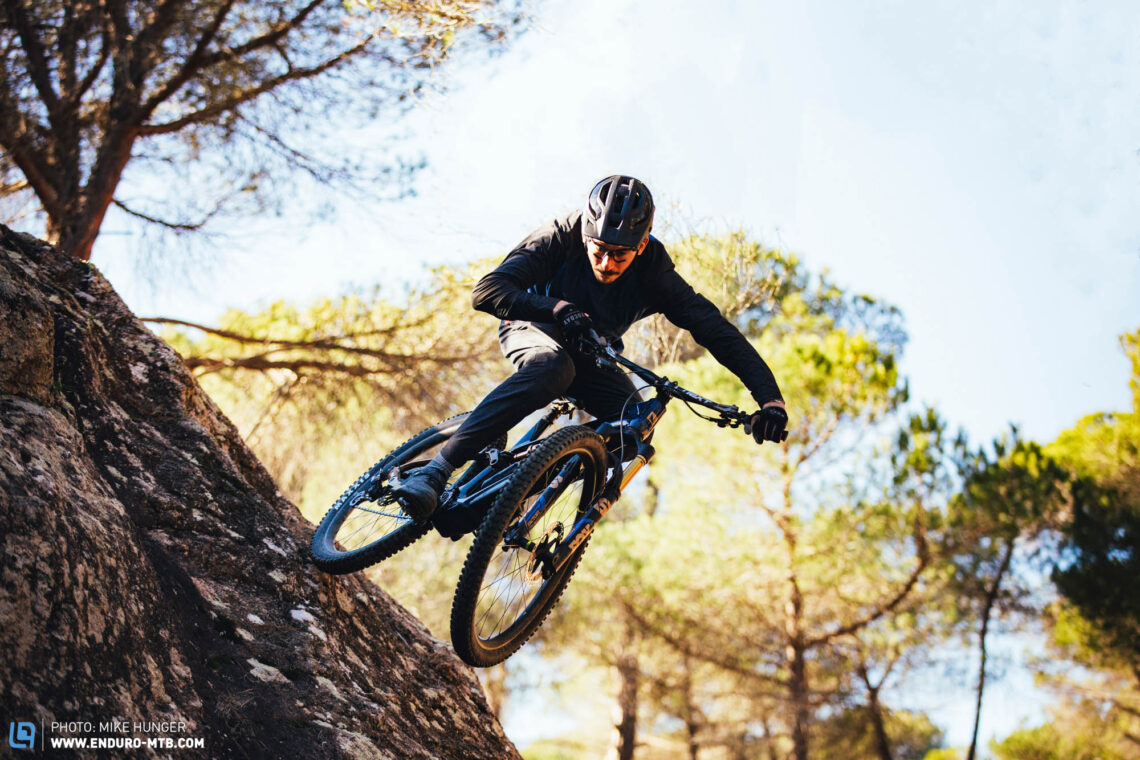
German ebike pioneers Haibike have kept us waiting for a Light-eMTB and they weren’t all that present in the more aggressive mountain bike sector, yet they have made a great Light-eMTB debut with their Haibike LYKE CF SE, featuring some clever solutions. They’re the only brand to tilt the FAZUA Ride 60 motor upright in the bike and thus hide it in the seat tube. However, this also comes at the cost of insertion depth for the seat post. While the LYKE looks very aggressive at first glance, its trail performance doesn’t match. Compared to the competition, it’s difficult to control on technical trails and quickly feels overwhelmed.
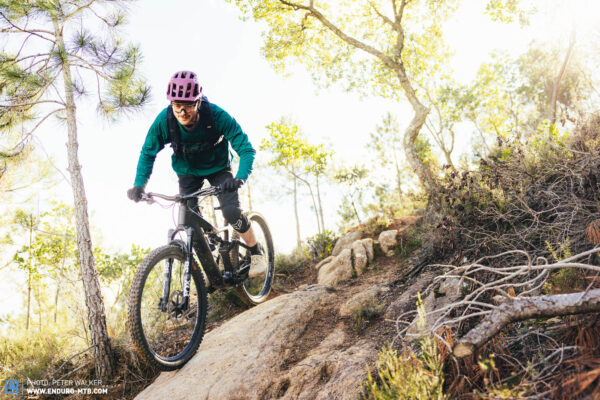

With its black finish, the FOCUS JAM ² SL 9.9 doesn’t just look inconspicuous, but also offers unspectacular handling. But this is by no means a bad thing as the JAM² SL is a predictable all-rounder that combines comfortable touring characteristics with strong trail capabilities. The solid spec, good suspension, and super easy handling make it an excellent weapon of choice for beginners and experts alike – and that at the most affordable price point. However, always having to remove the battery for charging is annoying.
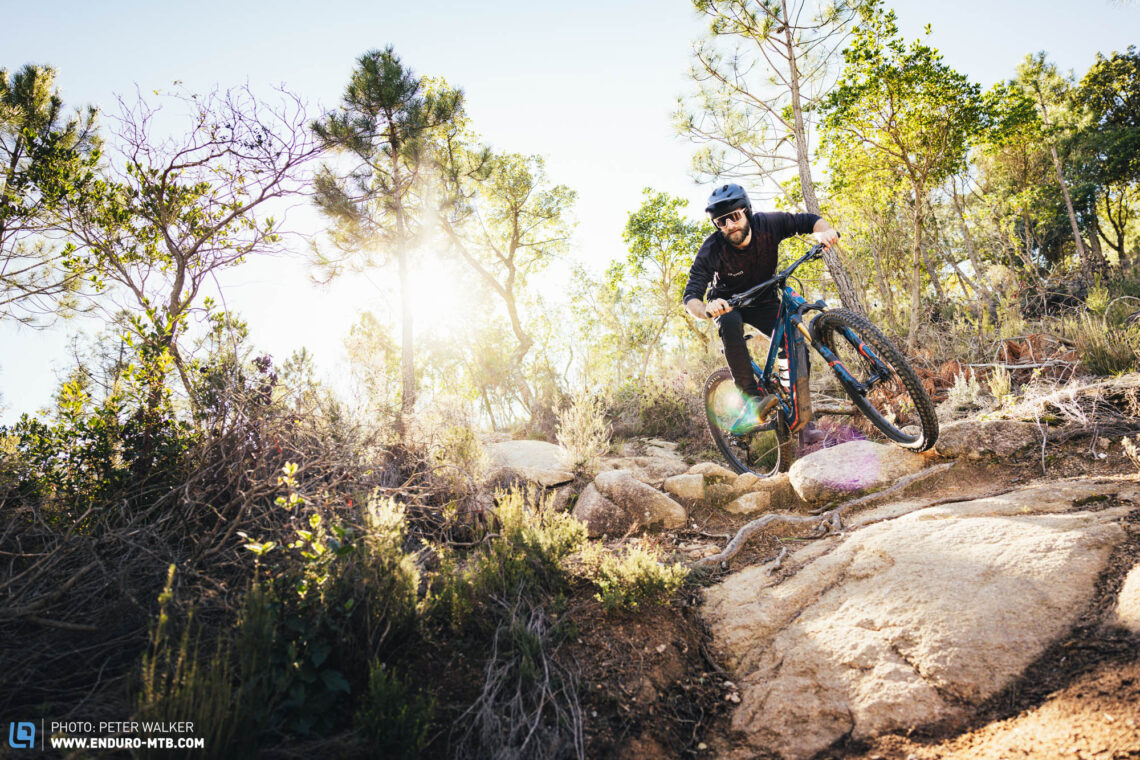
The Pivot Shuttle SL Pro X01 was the first Light-eMTB available to consumers featuring the FAZUA Ride 60 motor. It features Pivot’s signature DW-Link rear suspension, making it super efficient up the climbs and poppy on the descents, putting a big grin on your face in flowy terrain. Together with the responsive steering and fast colour, it takes us back to our BMX racing days.

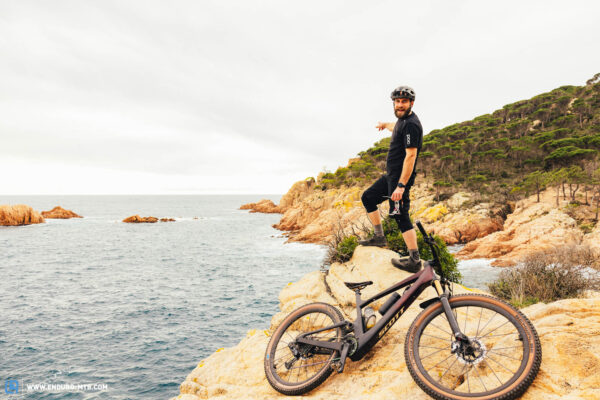
The master of integration, the SCOTT Lumen eRIDE 900 SL is powered by the TQ HPR 50 motor. It’s not just the shock that’s hidden in the frame, but you’ll also find countless features and tools in every conceivable nook and cranny. As its looks suggest, the Lumen climbs mountains like nothing else with its cross-country genes, but it turns out to be capable on the descents, too. Nevertheless, priced at € 15,999, the SCOTT will break most bank accounts while catering to a very limited use case.
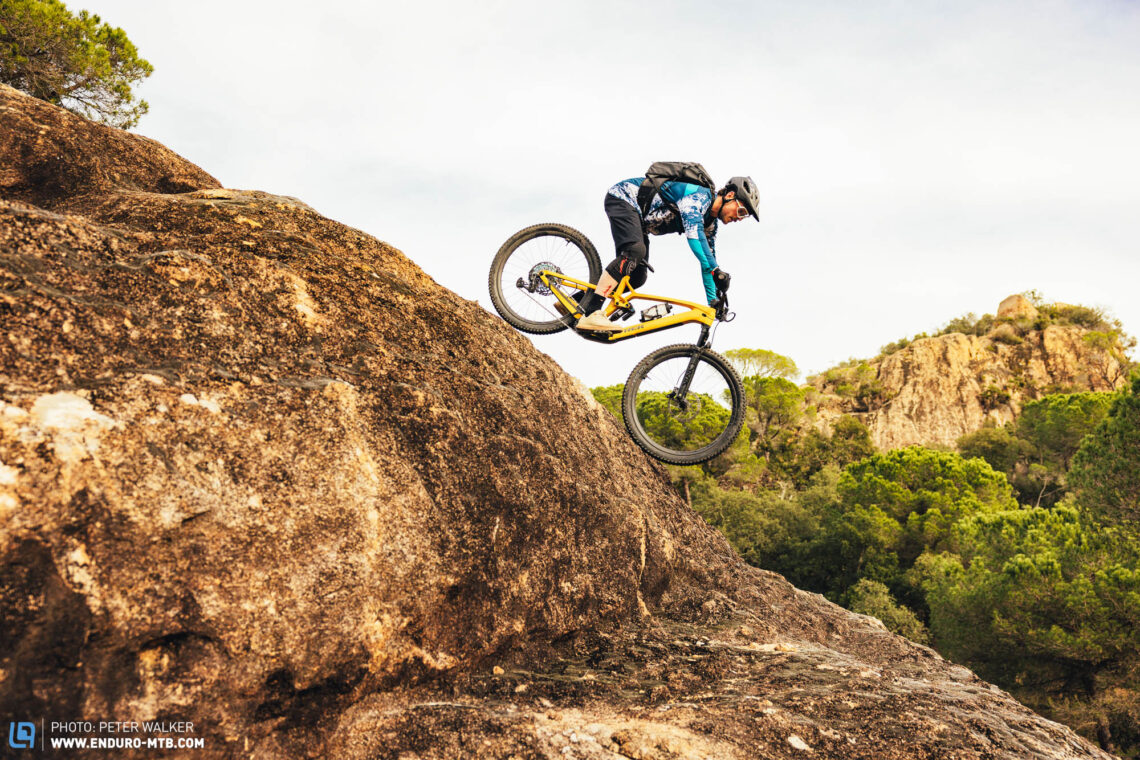
The € 14,499 Trek Fuel EXe 9.9 XX1 AXS is also damn expensive, but it’s much more versatile. The drive unit in the Trek was developed in an exclusive cooperation with TQ and though other manufacturers now rely on the same motor, Trek still have some cool advantages thanks to their own software and app. For one, the display is more intuitive to use, and you’ve got a wider range of functions via the in-house app. The Trek is capable of handling pretty much everything on the trail, but it’s not a master at anything, rolling along inconspicuously and with beginner-friendly handling.
The best Light-eMTB 2023: The SIMPLON Rapcon PMAX TQ

19.4 kg in size XL | € 12,999
Winner genes? Indeed! Its analogue counterpart – on which the SIMPLON Rapcon PMAX TQ is based – already won the title of the best enduro bike two years ago. Now the Austrian brand have neatly integrated the TQ motor into the frame, piecing together a damn good overall package. The bike’s character suits the motor to a tee and despite its low power output, the Rapcon can pull away from most of the competition thanks to its efficient rear suspension. The SIMPLON lets you blast down the descents and instils you with the confidence to keep pushing with its super easy handling, incredible composure, and unmatched suspension. Without question, the best Light-eMTB of 2023!
Our Best Buy: The Orbea Rise M-LTD
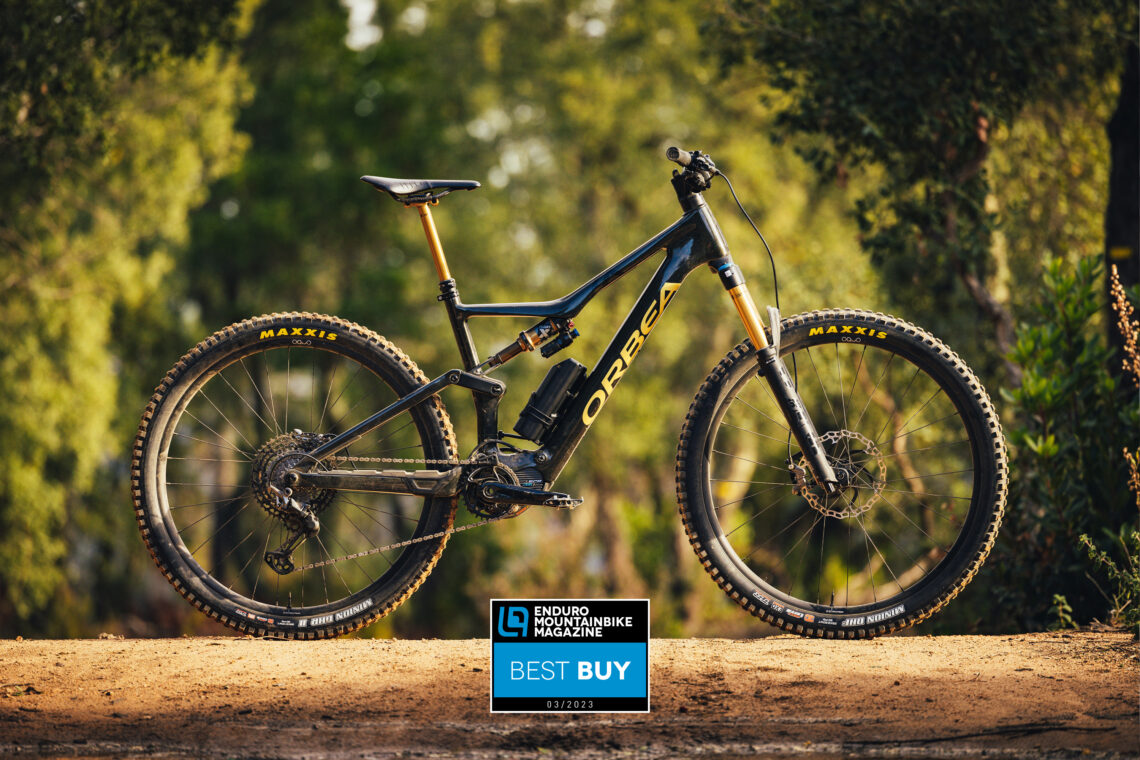
18.8 kg in size L | € 10,255
Thanks to the extensive online configurator, the new Orbea Rise M-LTD can be tailored to your needs both in terms of looks and components. You can even choose between a 360 Wh and 540 Wh internal battery. In combination with the optional range extender, the Rise has a bigger battery capacity than many full-power eMTBs. Speaking of full-power: Orbea throttle the integrated Shimano EP801 at 60 Nm, thus increasing your range further still. Despite that, it turns out to be the best climber on the trail and doesn’t have to hide on the descents either, thanks to its intuitive and good-natured handling. Our Best Buy!
All bikes in test: Focus Jam² SL 9.9 2023 (Click for review) | Forestal Siryon Diode (Click for review) | Haibike LYKE CF SE (Click for review) | Orbea Rise M-LTD (Click for review) | Pivot Shuttle SL Pro X01(Click for review) | SCOTT Lumen eRIDE 900 SL (Click for review) | SIMPLON Rapcon Pmax TQ (Click for review) | Trek Fuel EXe 9.9 XX1 AXS (Click for review)
Did you enjoy this article? If so, we would be stoked if you decide to support us with a monthly contribution. By becoming a supporter of ENDURO, you will help secure a sustainable future for high-quality mountain bike journalism. Click here to learn more.
Words: Peter Walker Photos: Peter Walker, Mike Hunger









